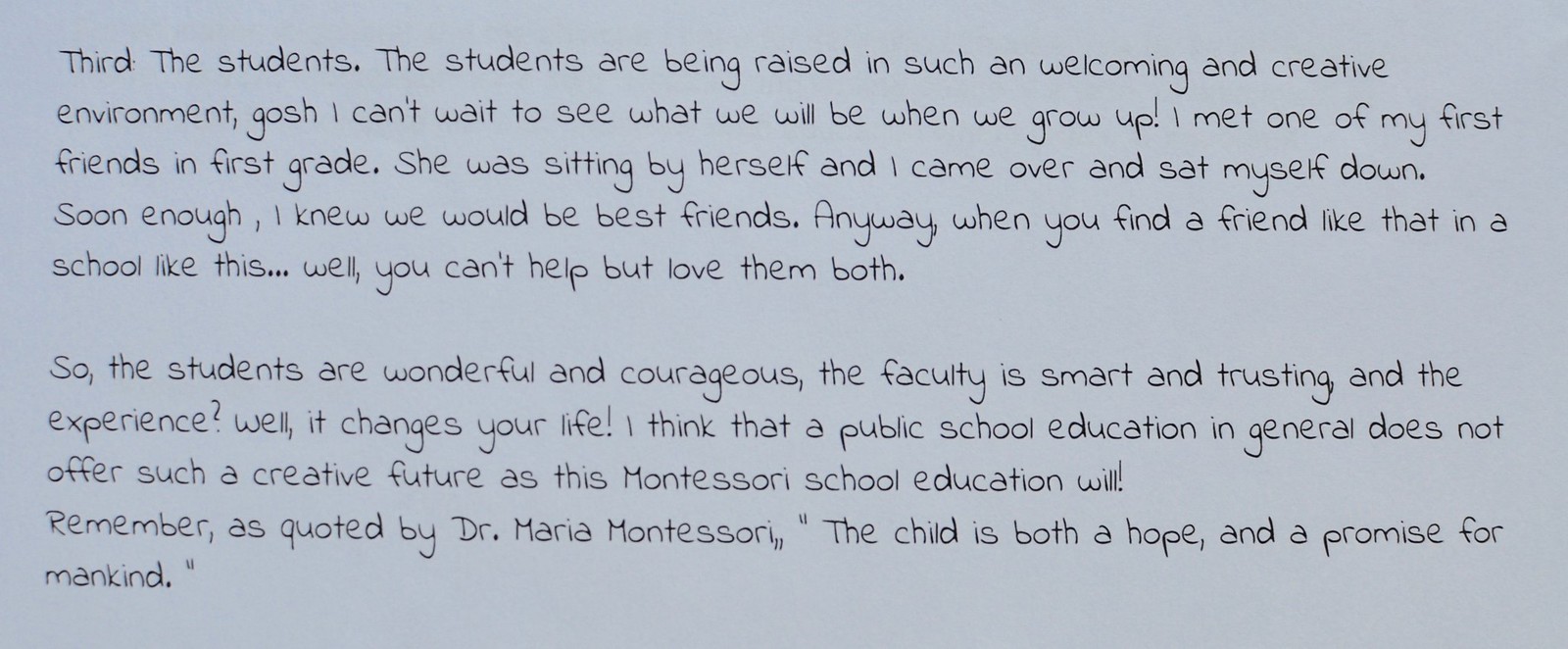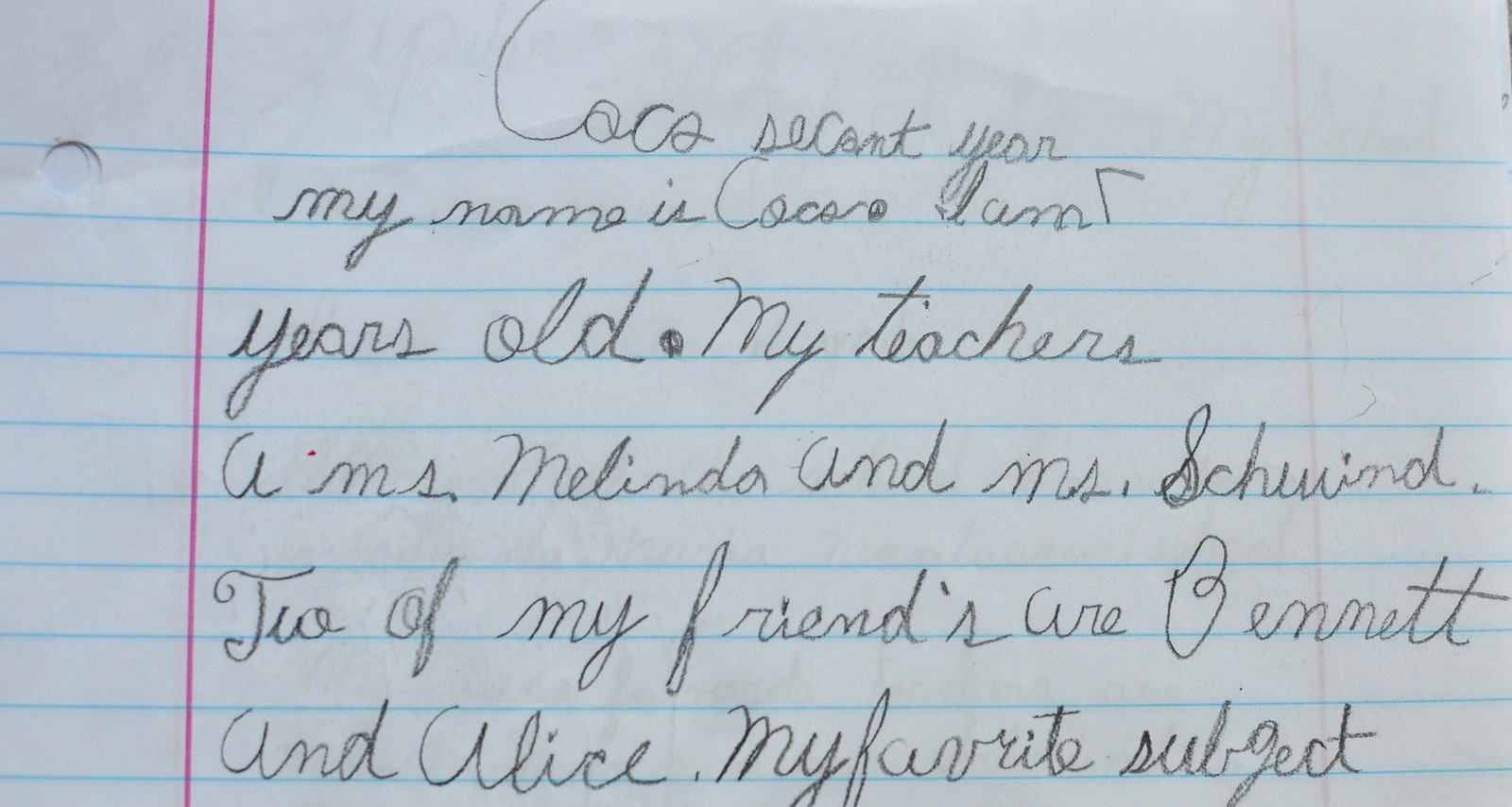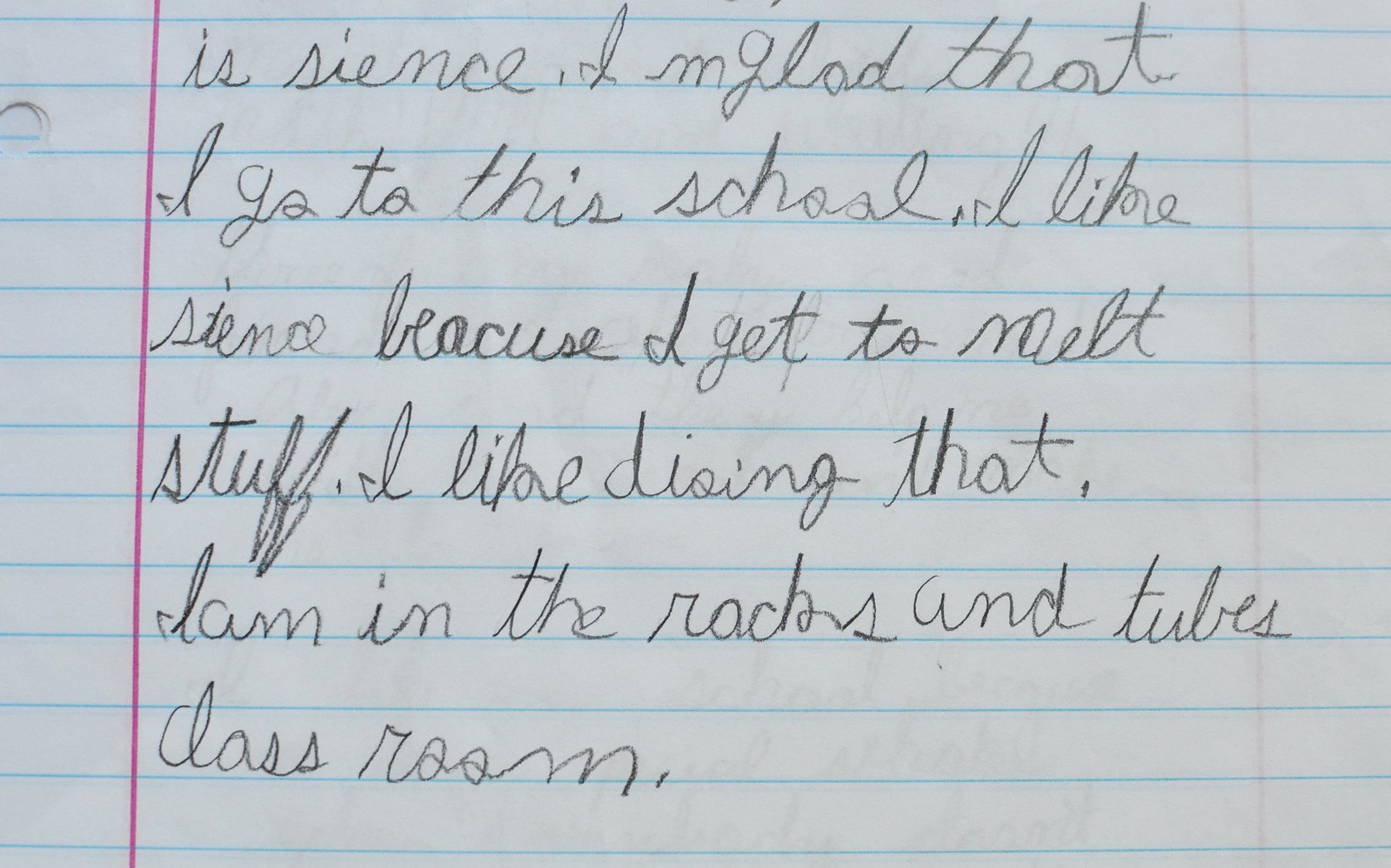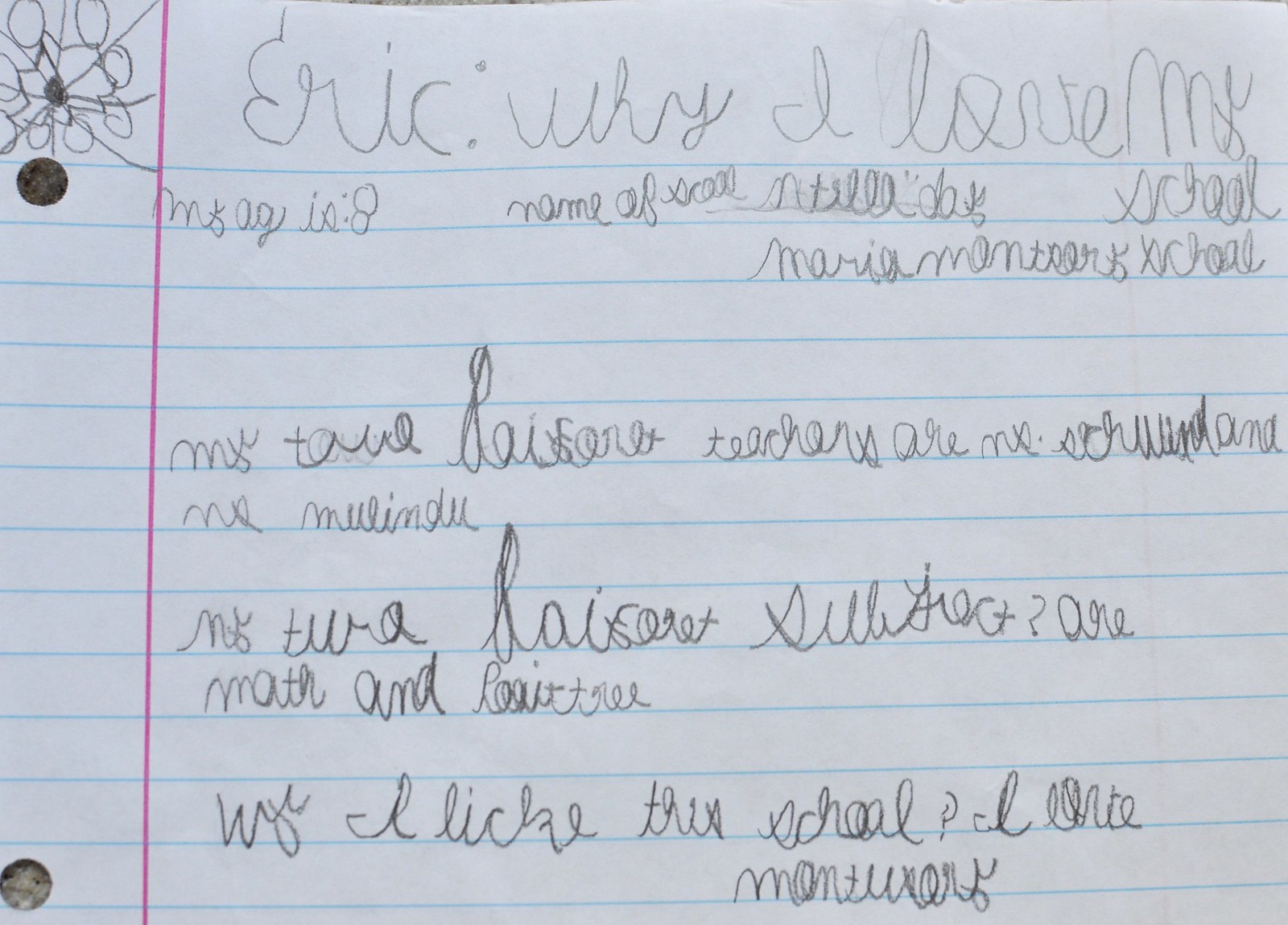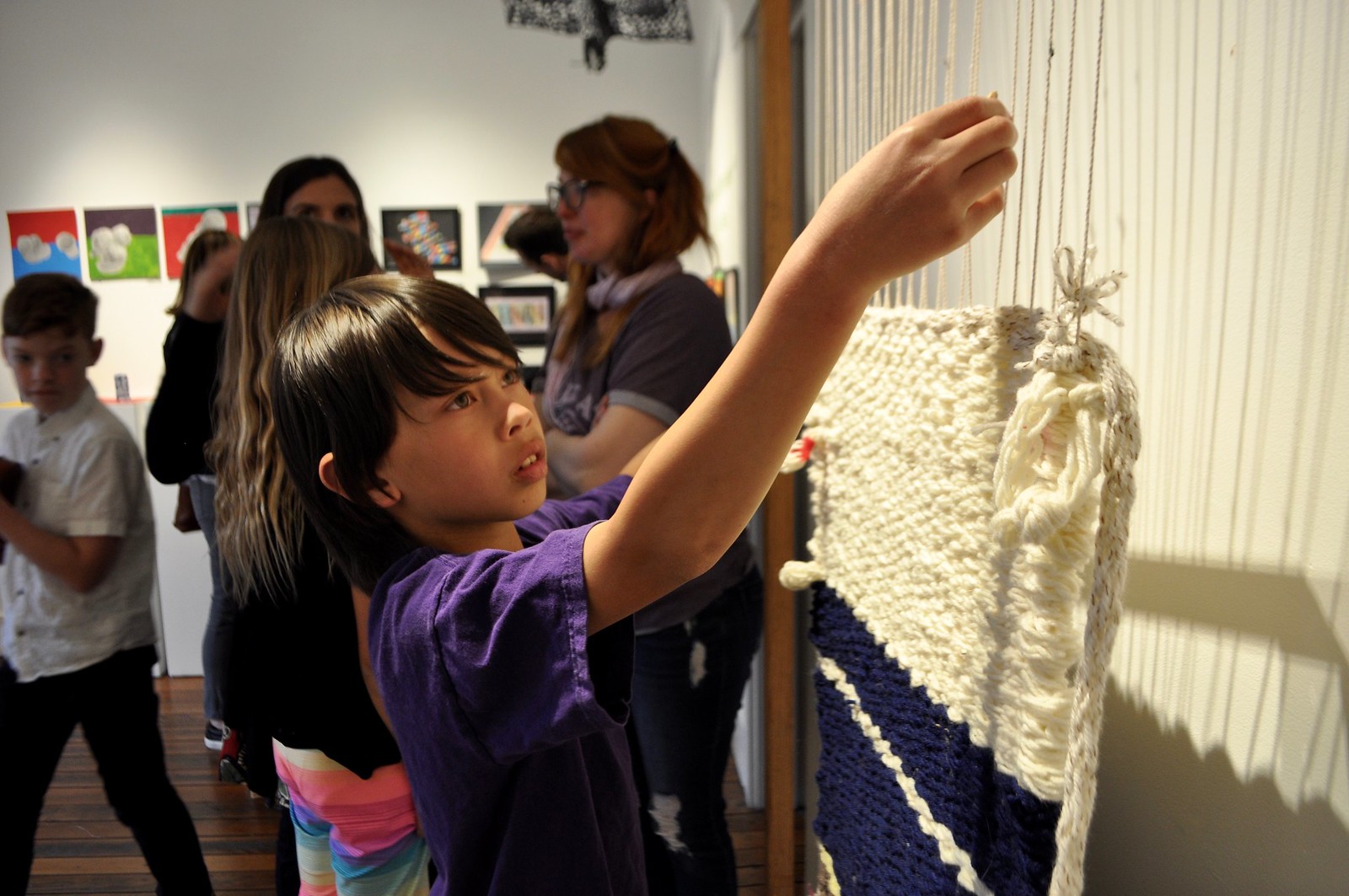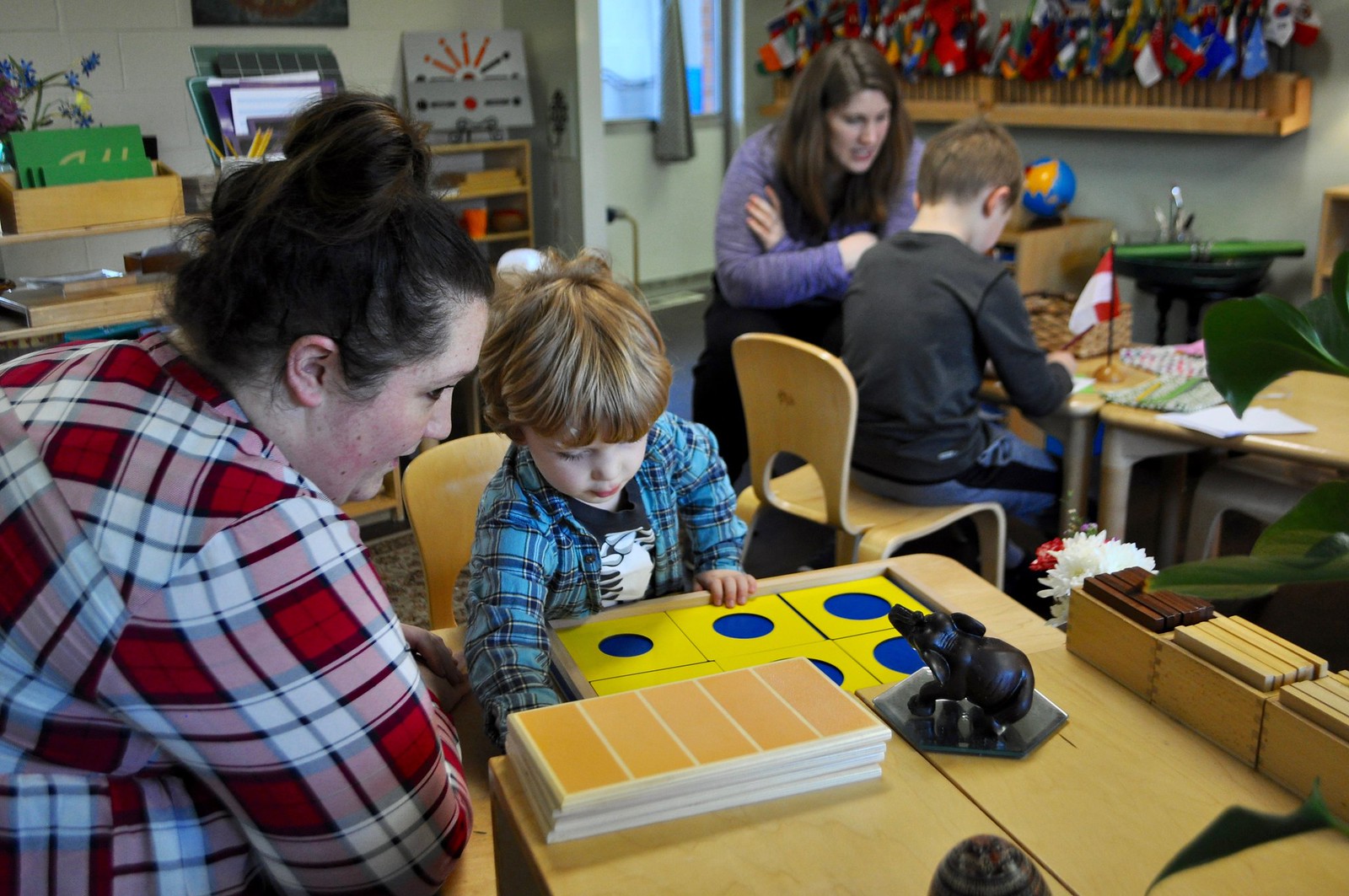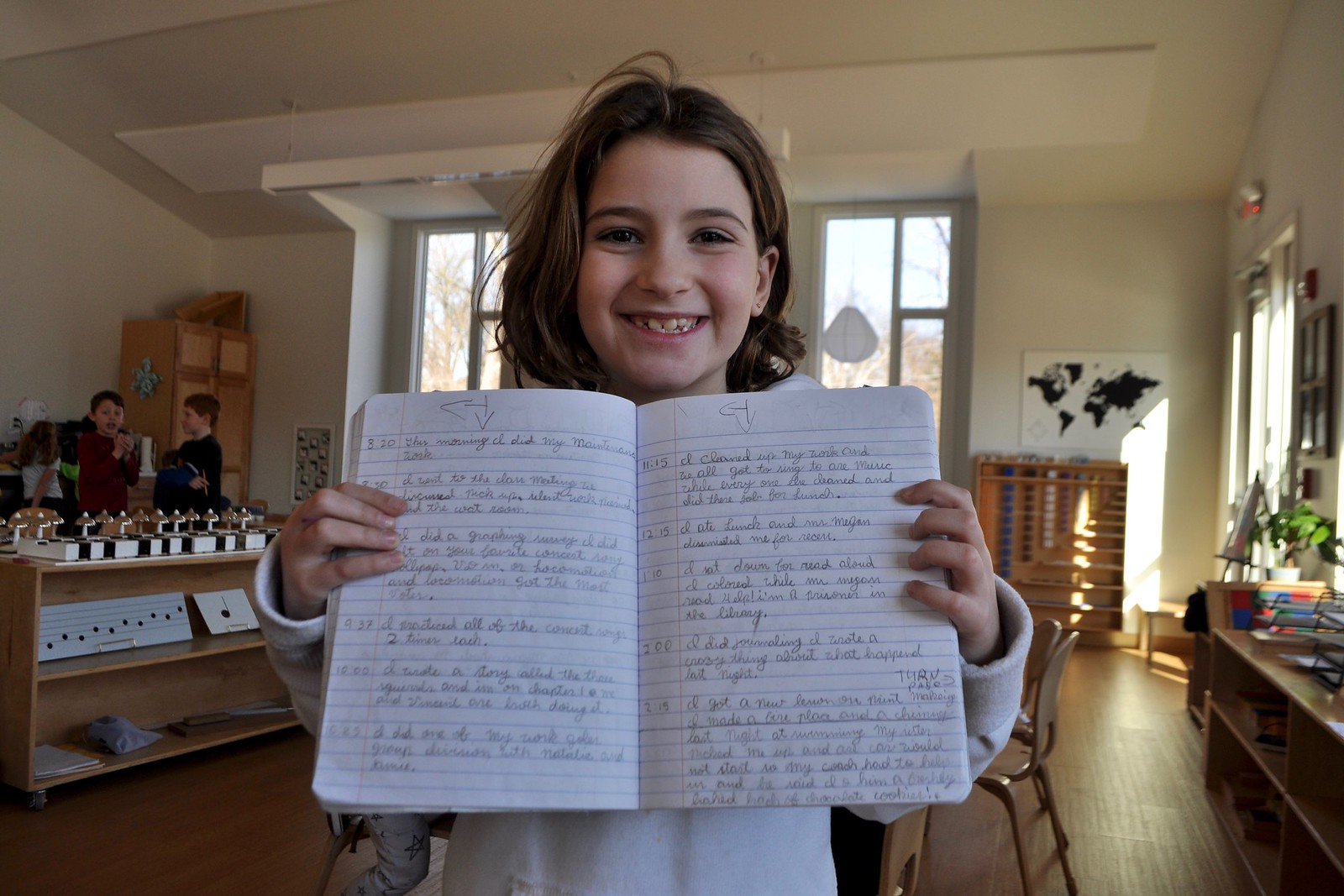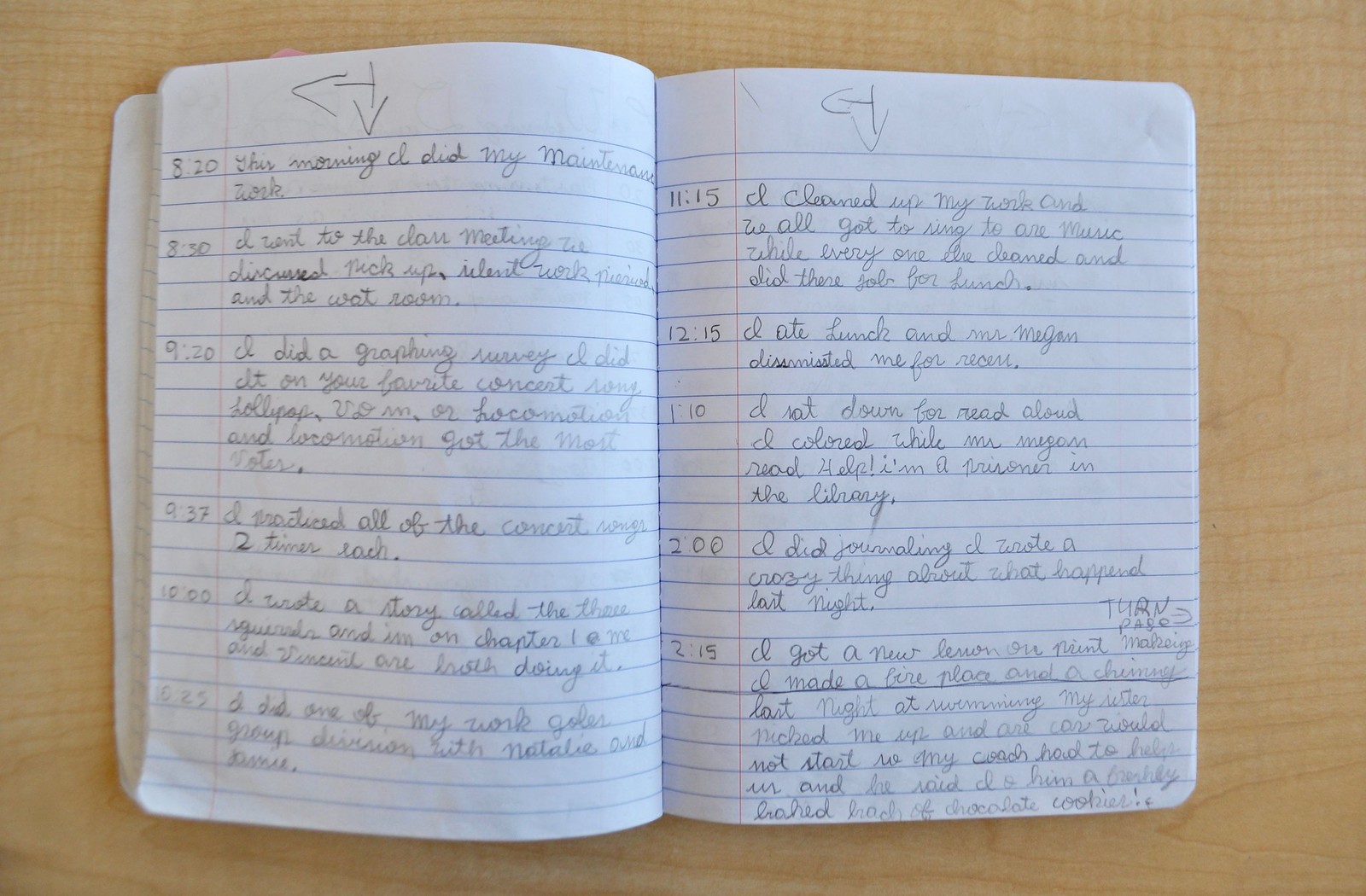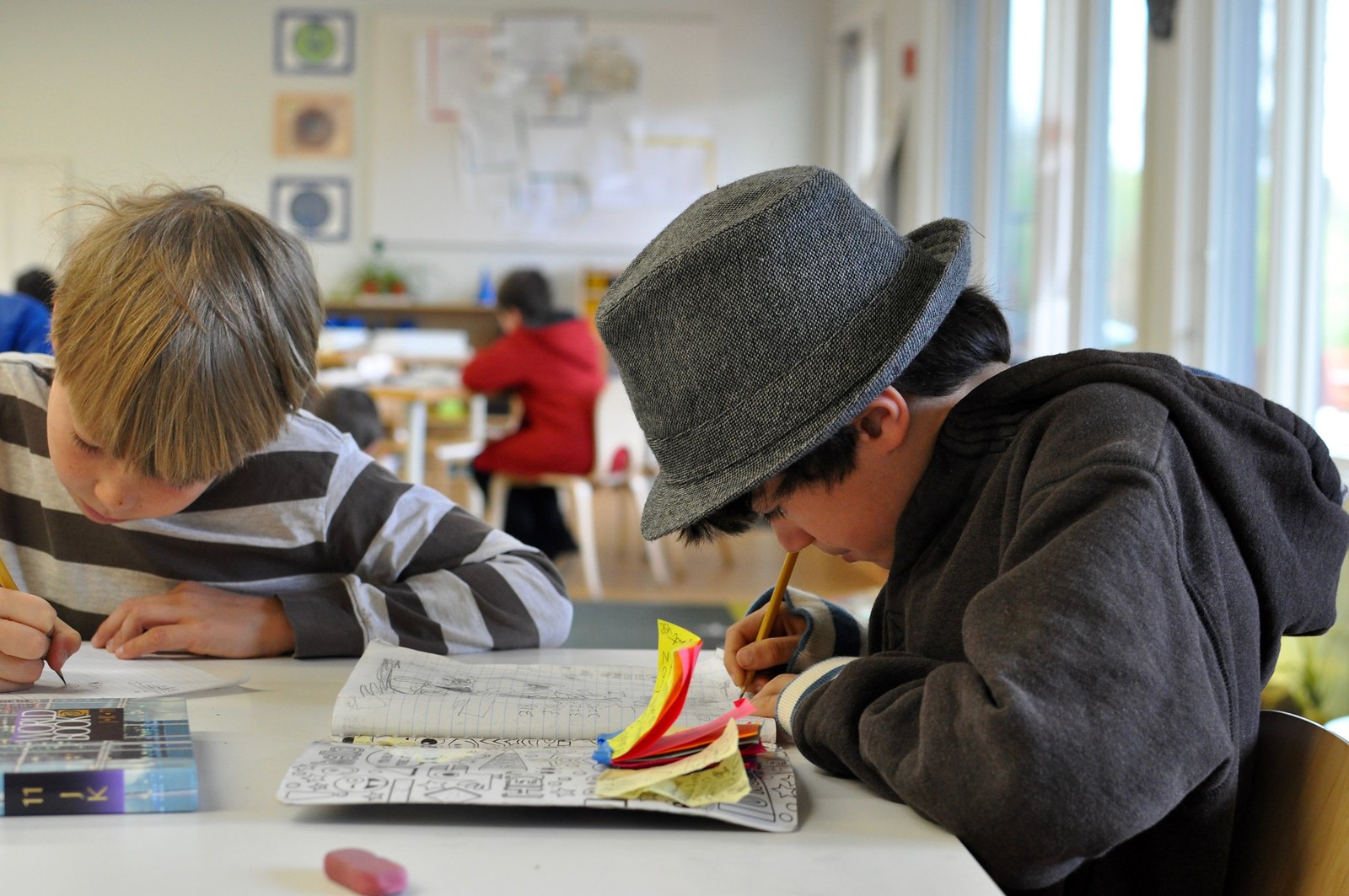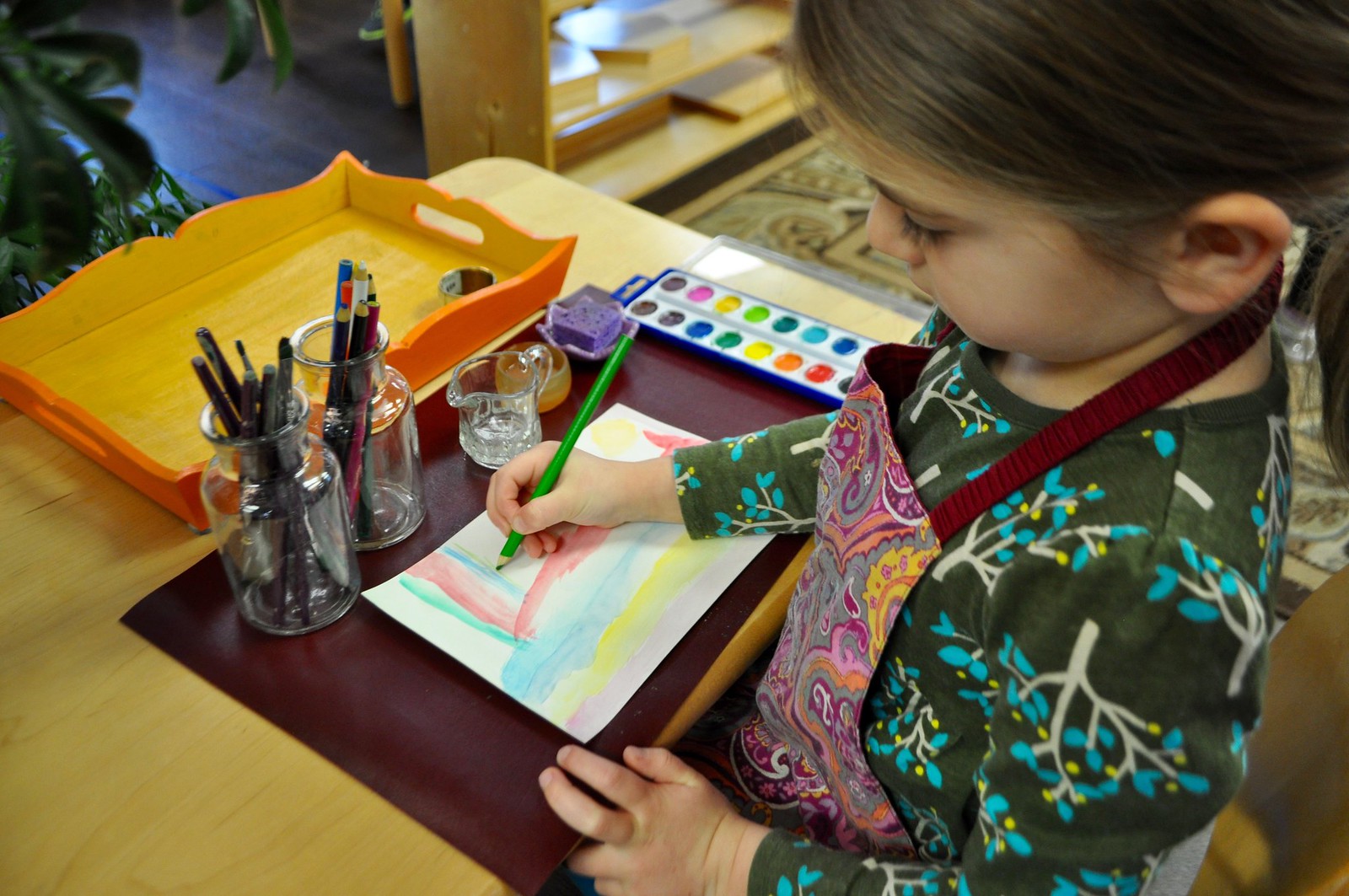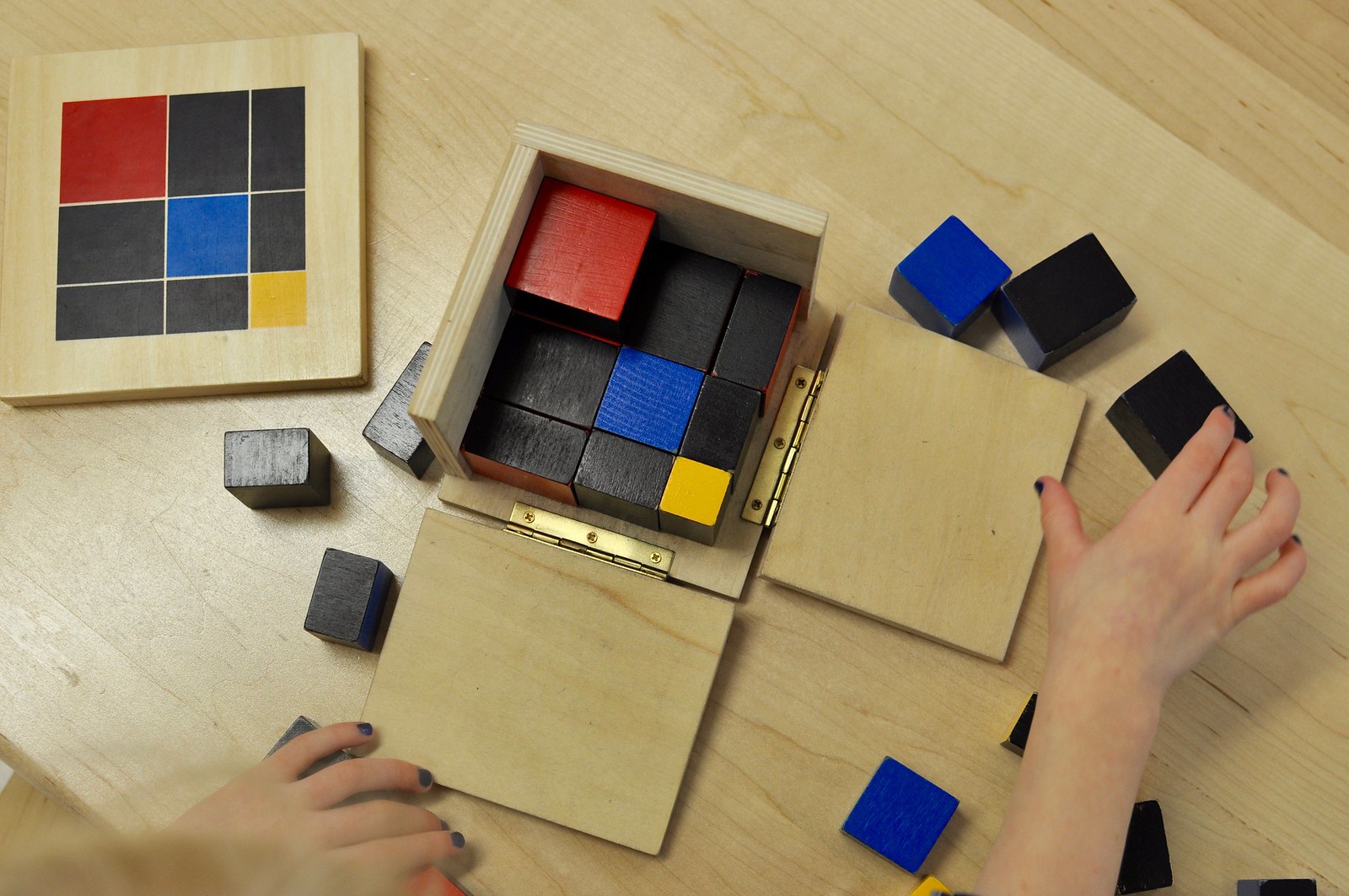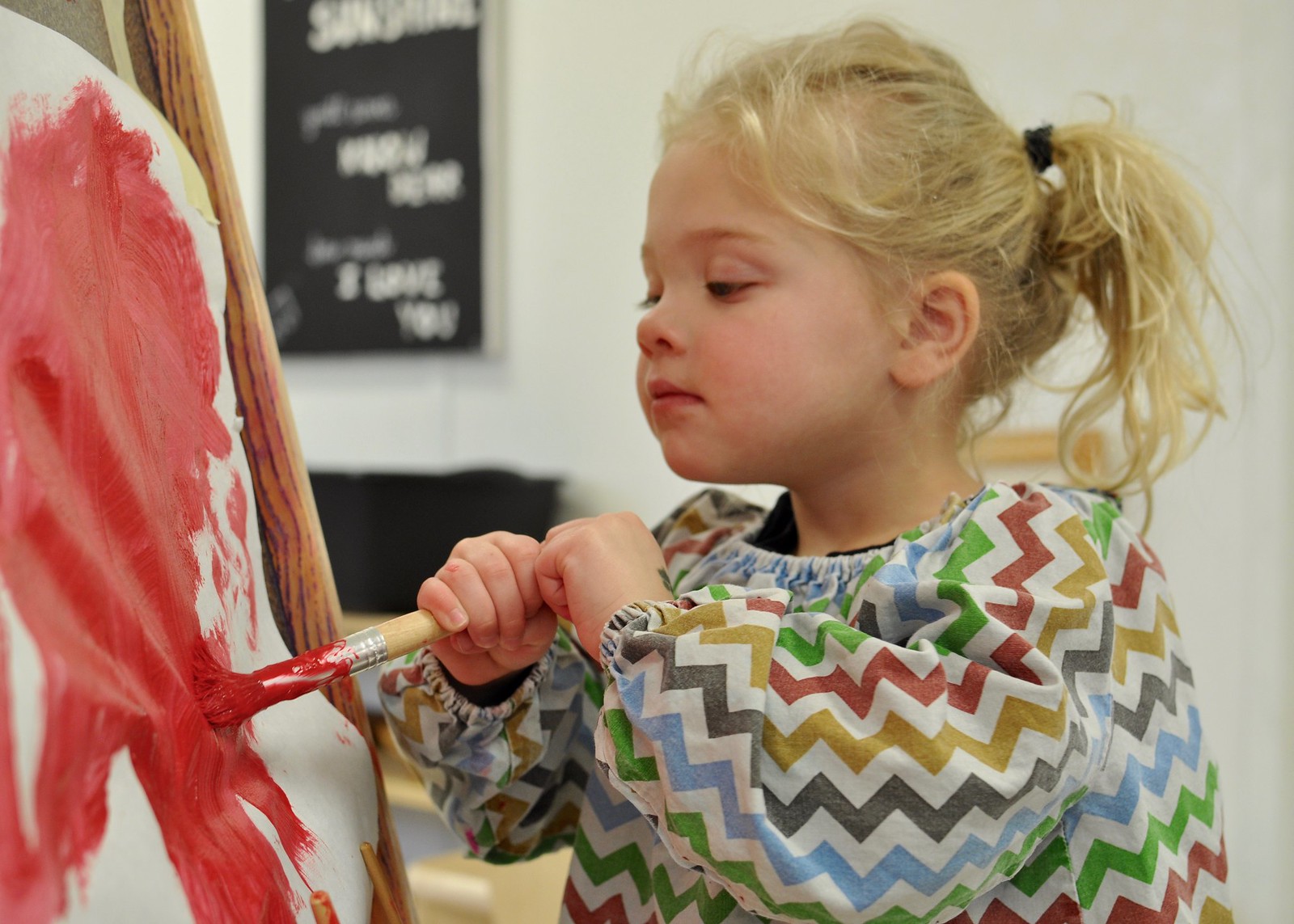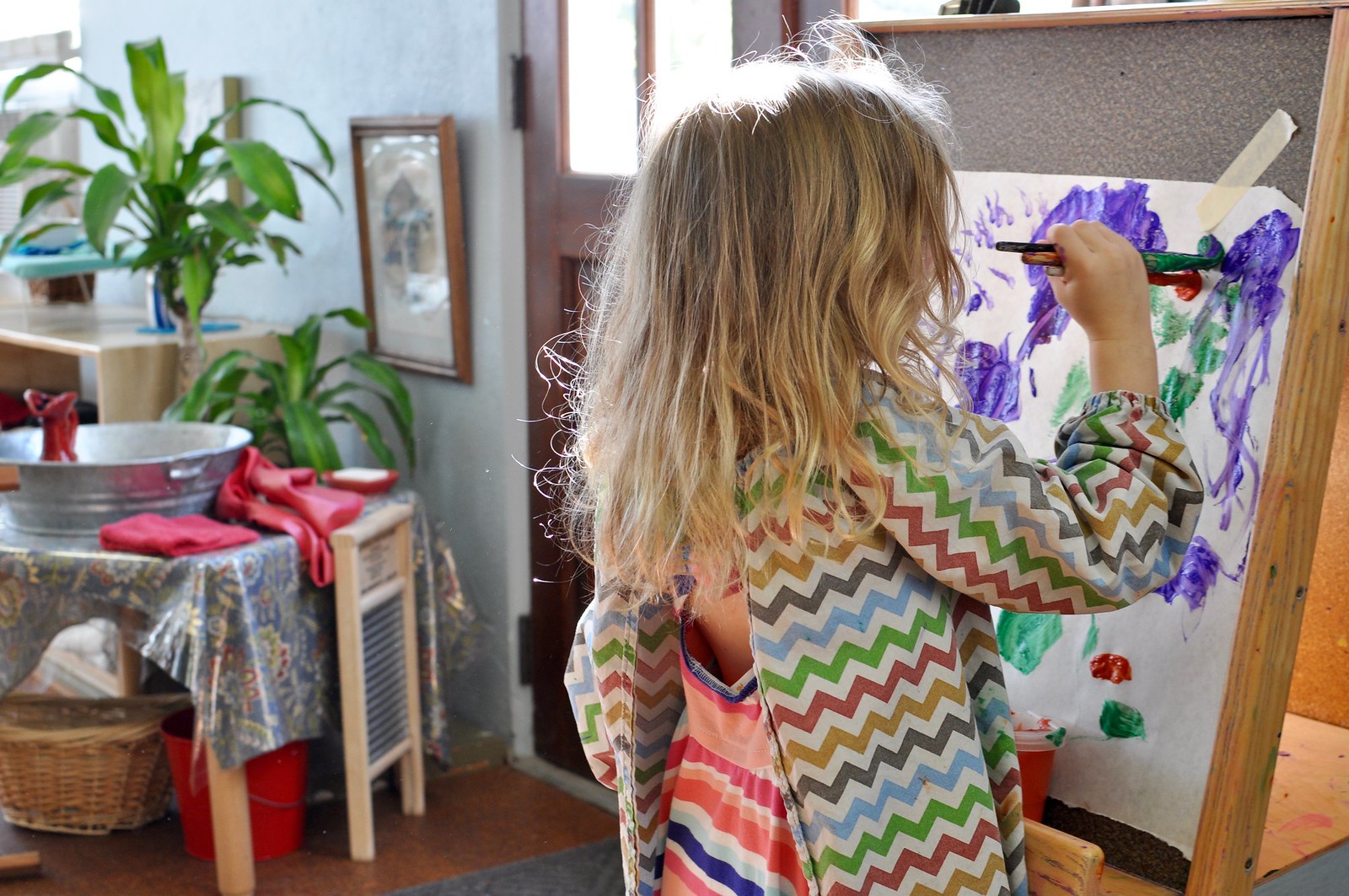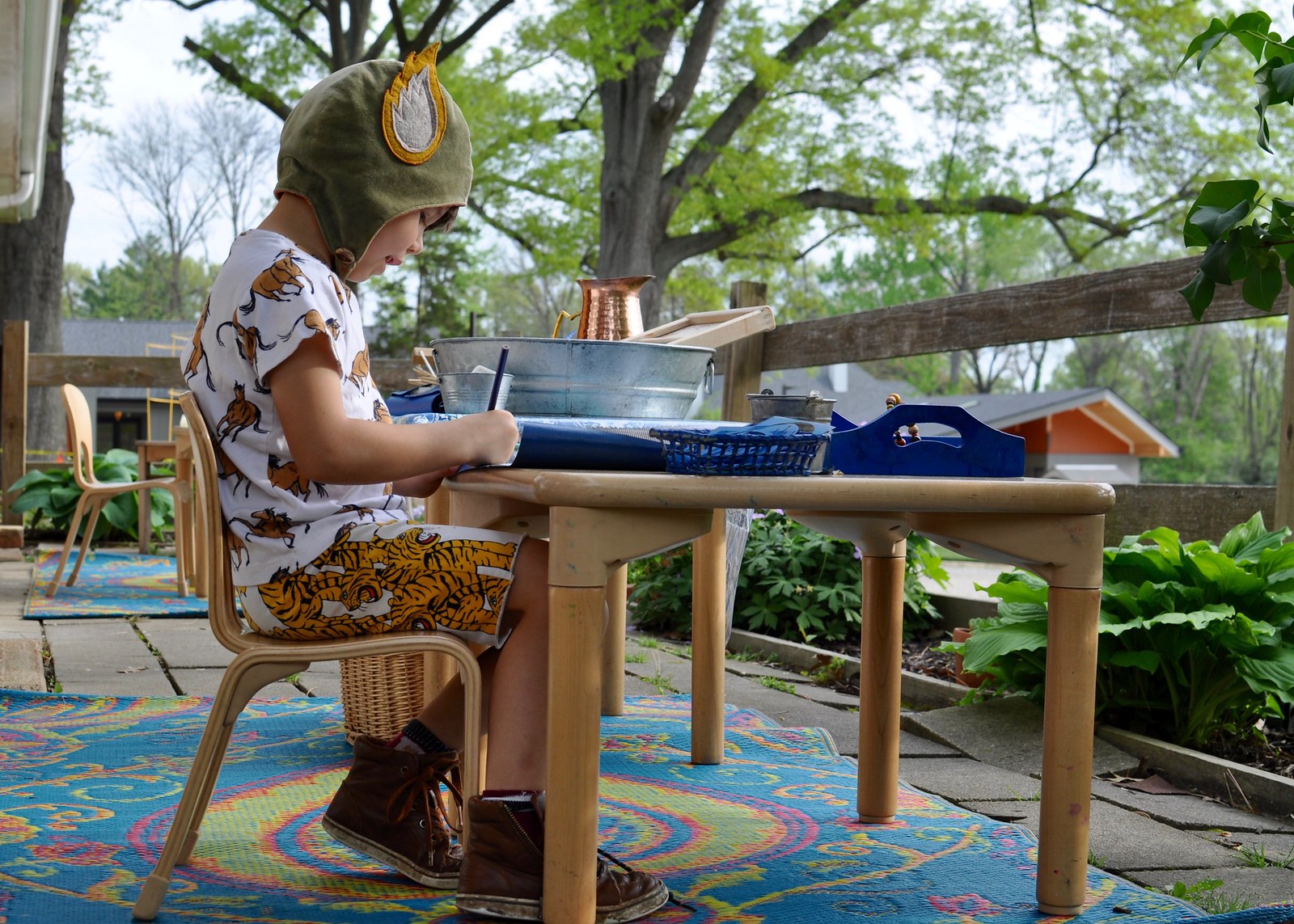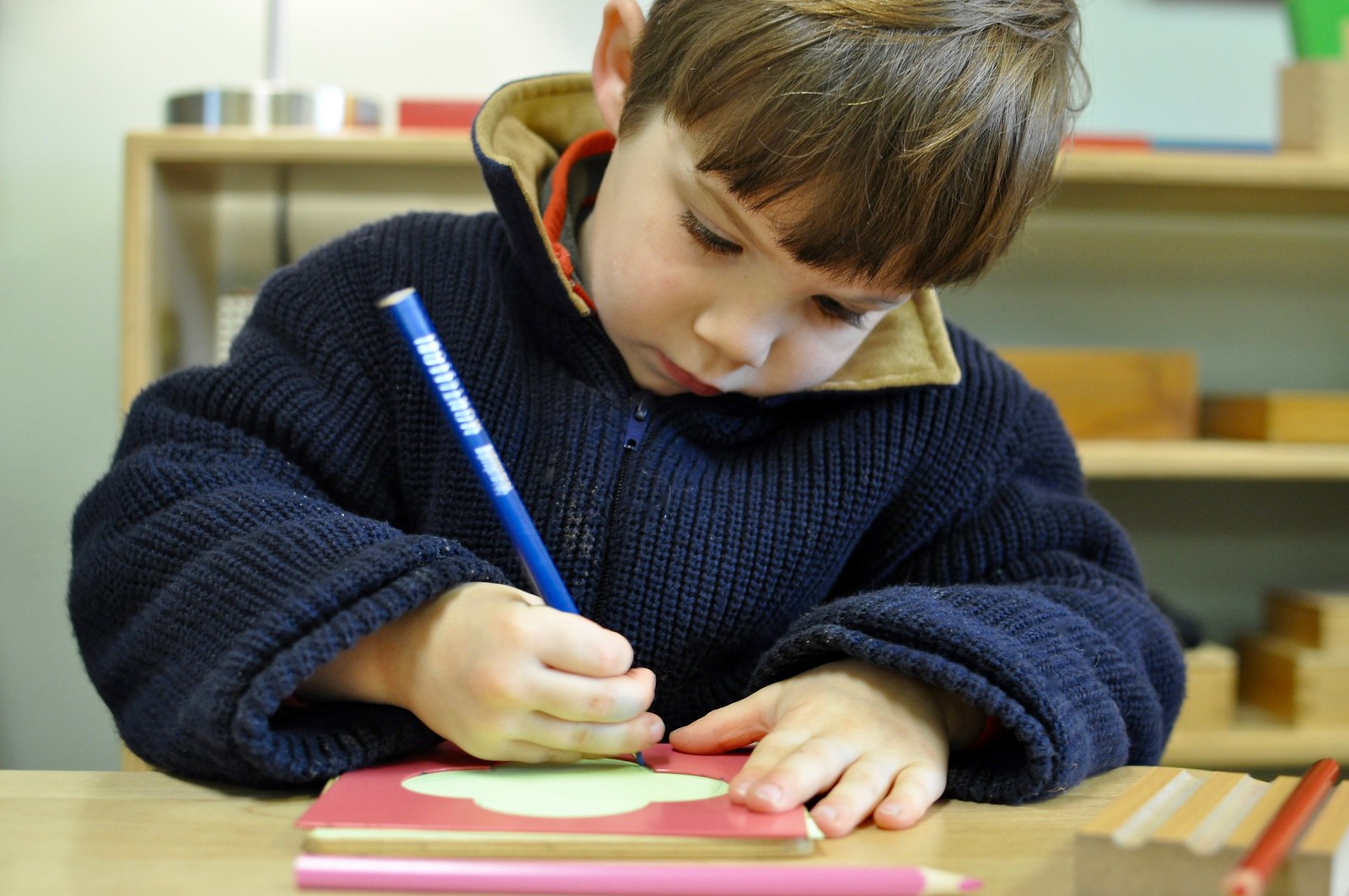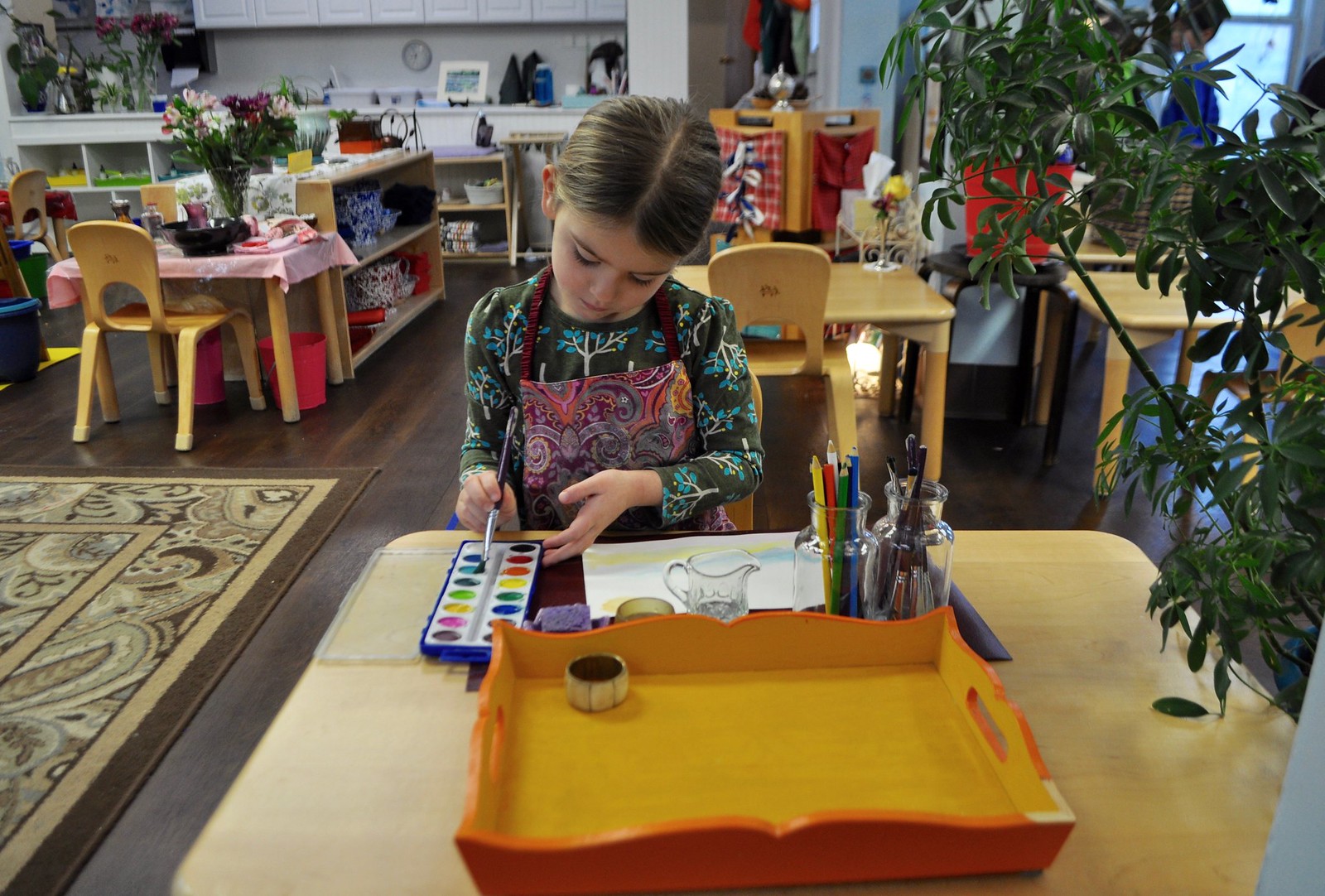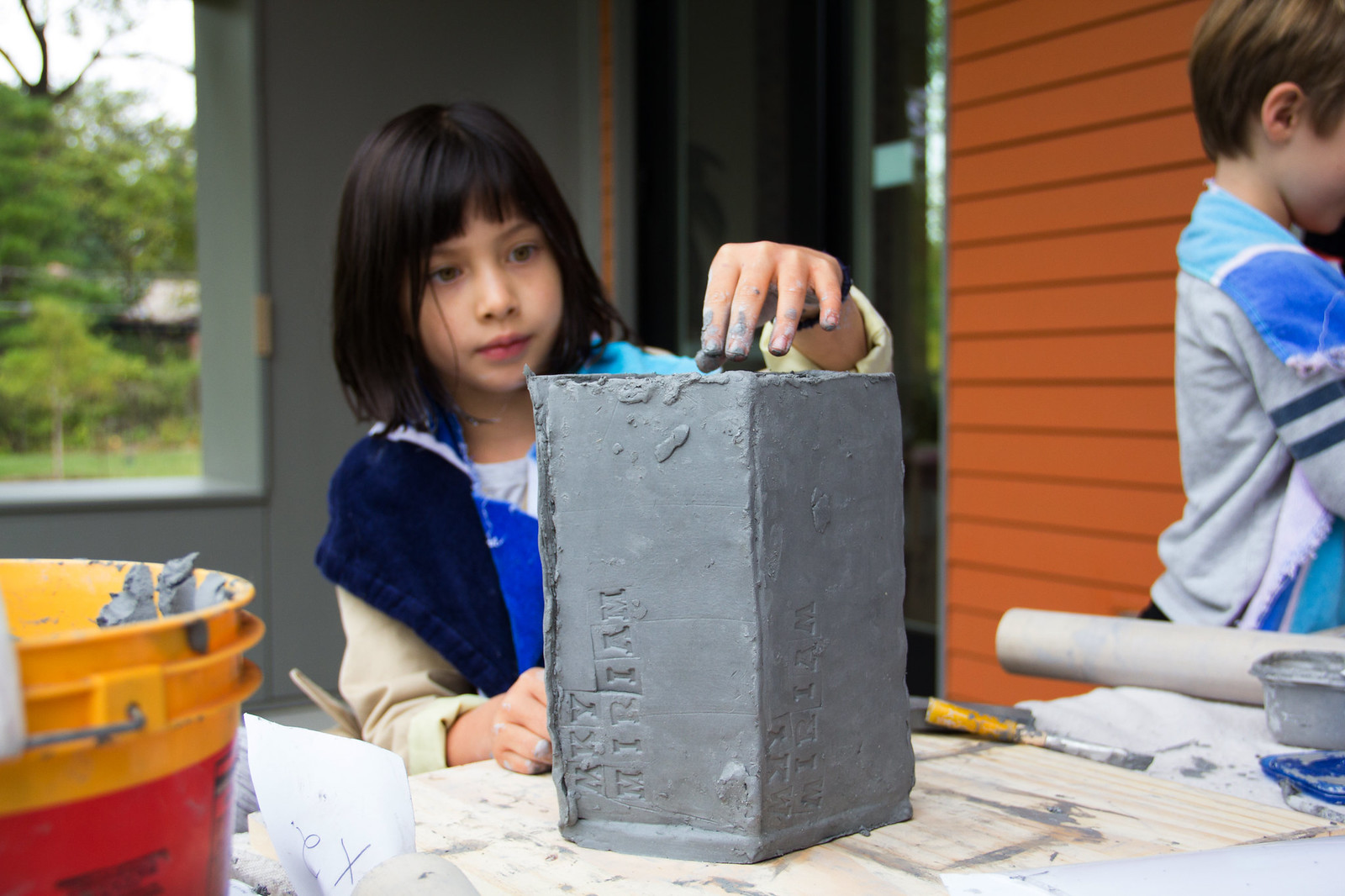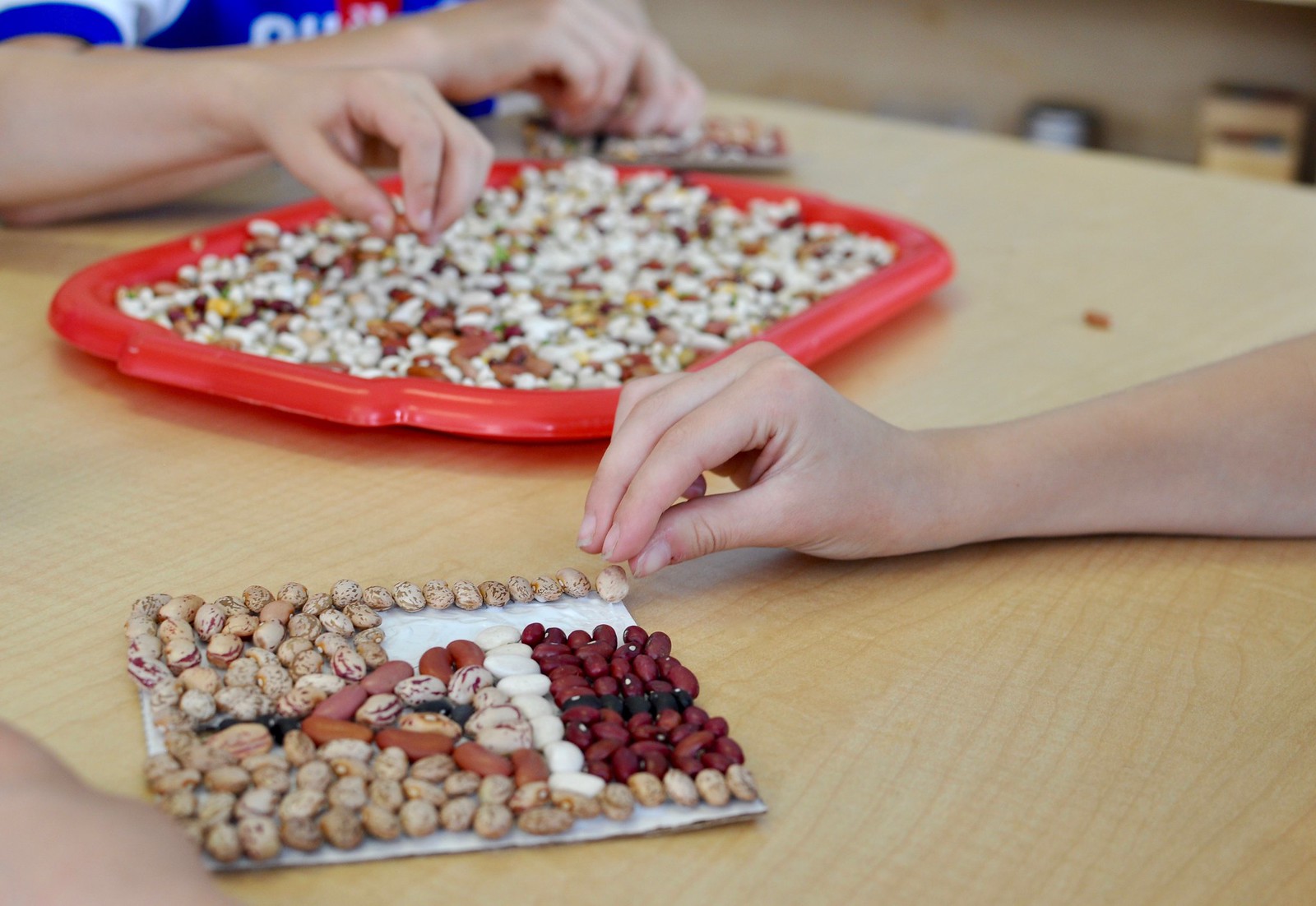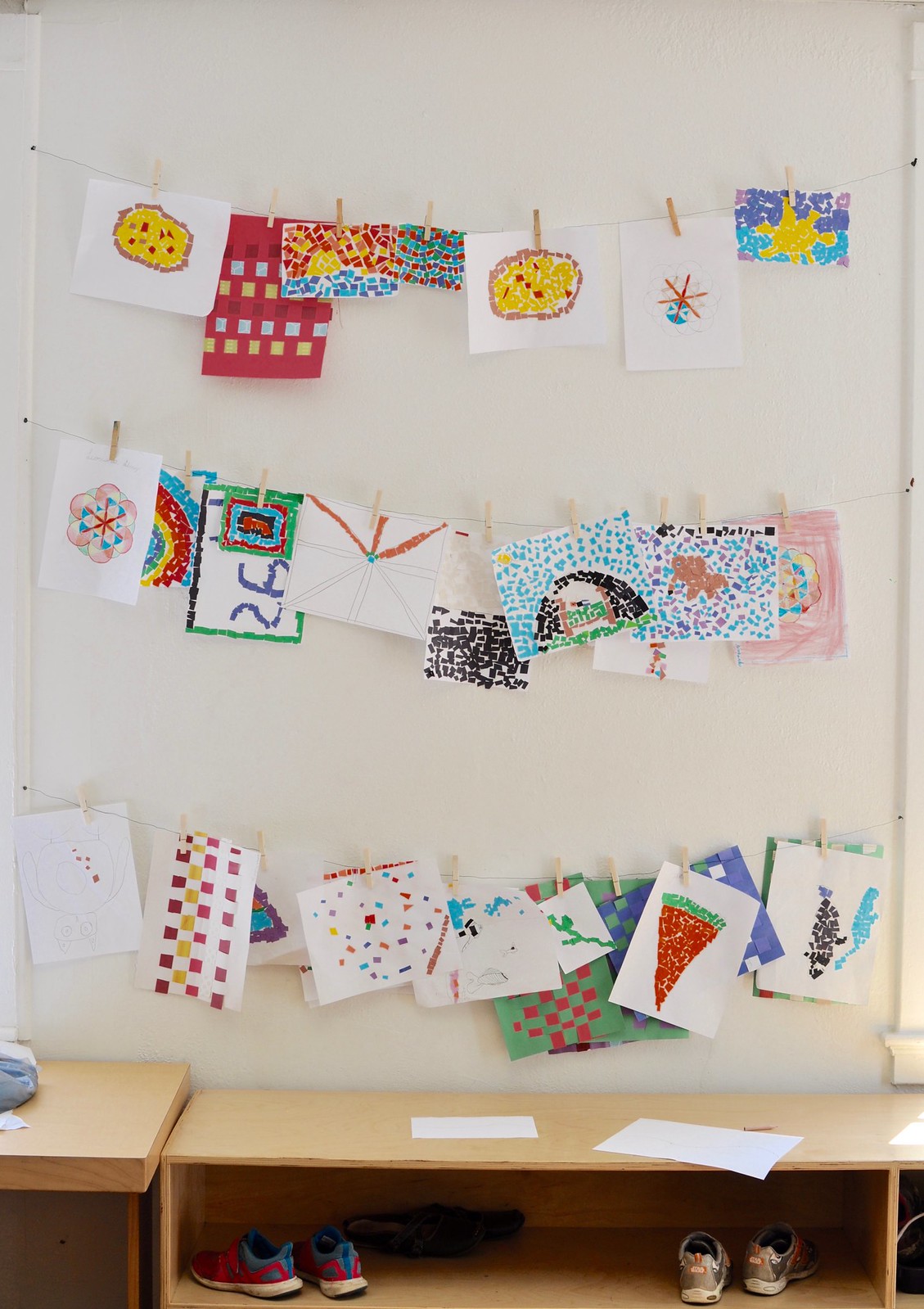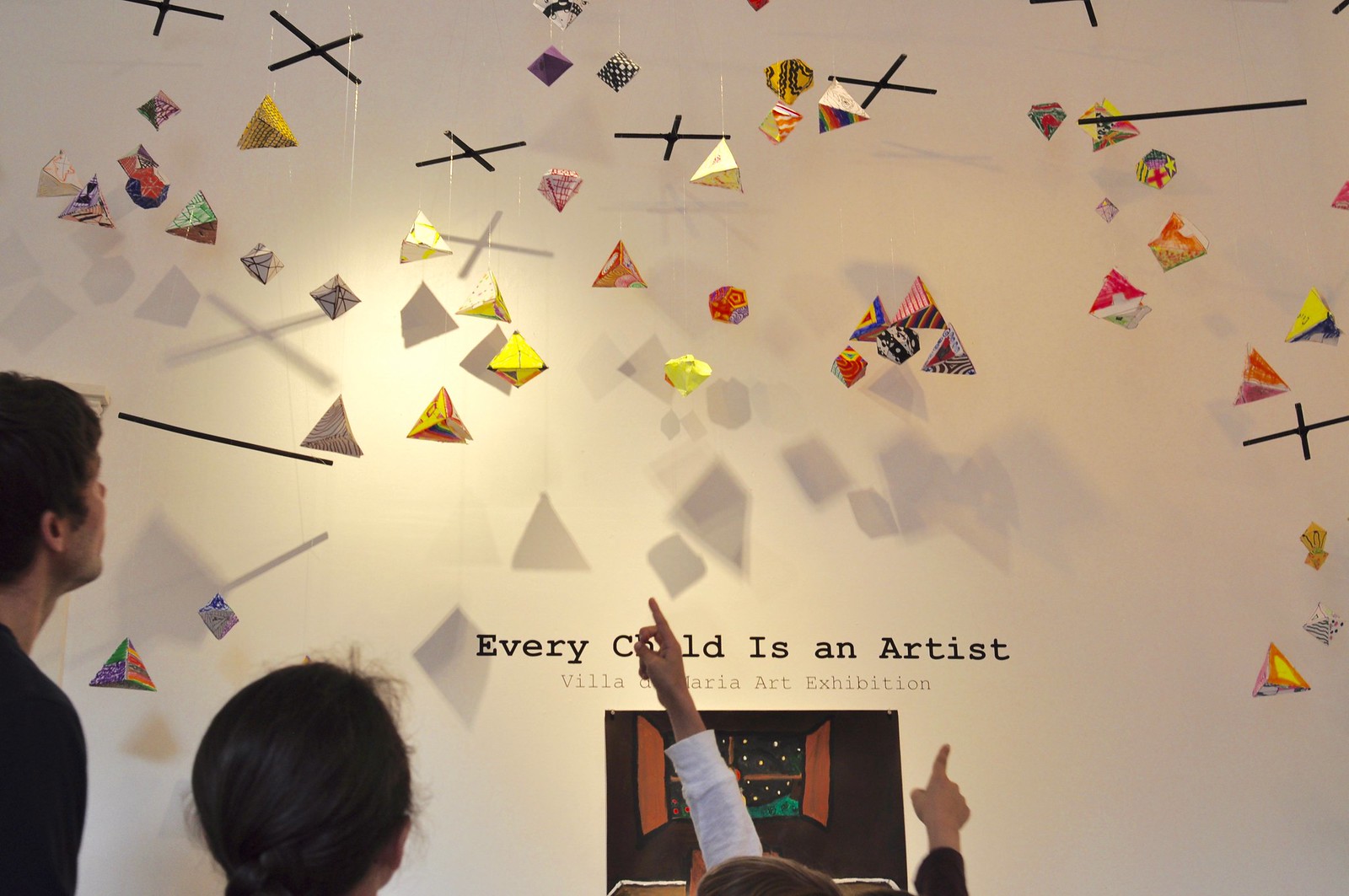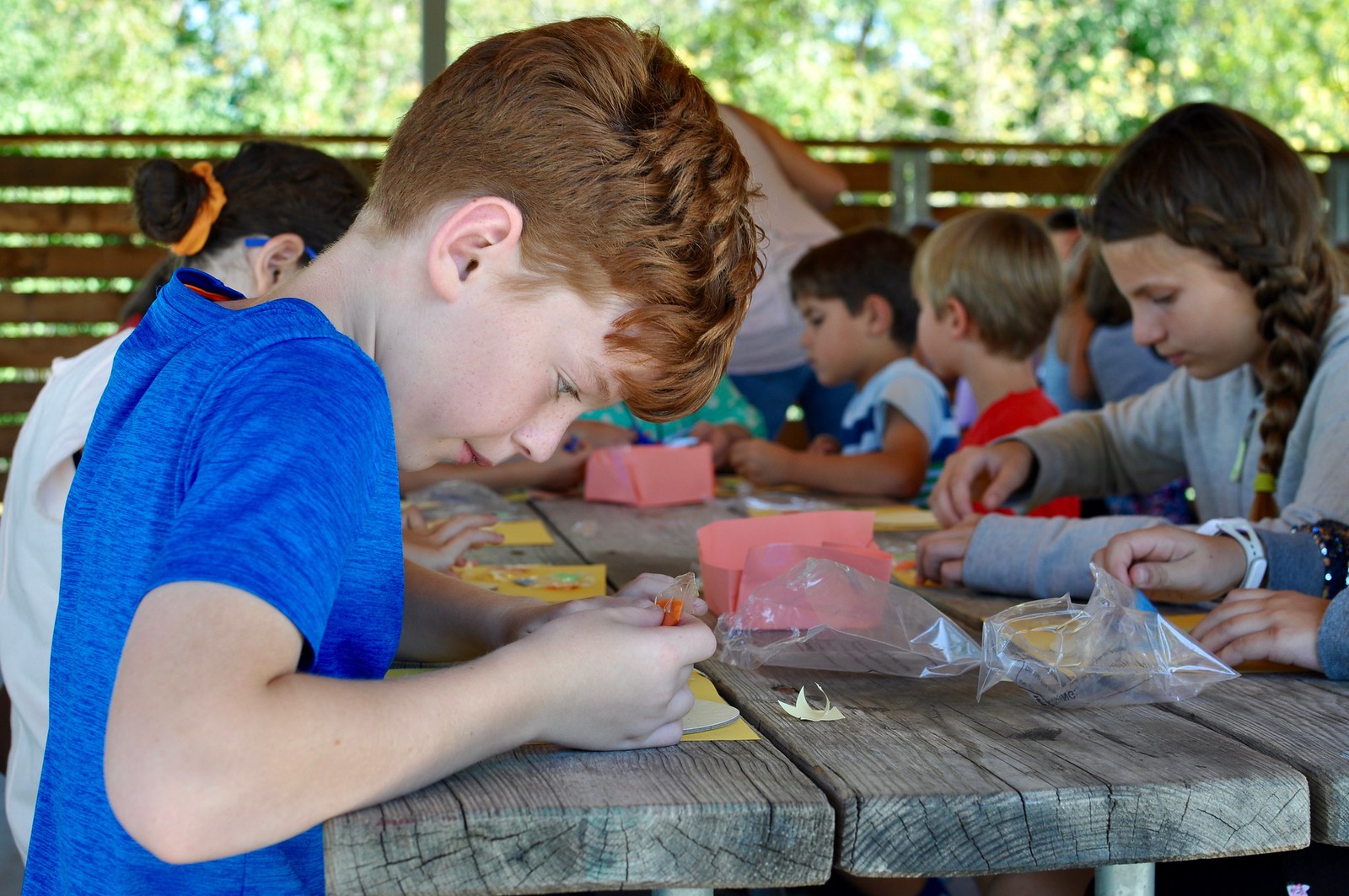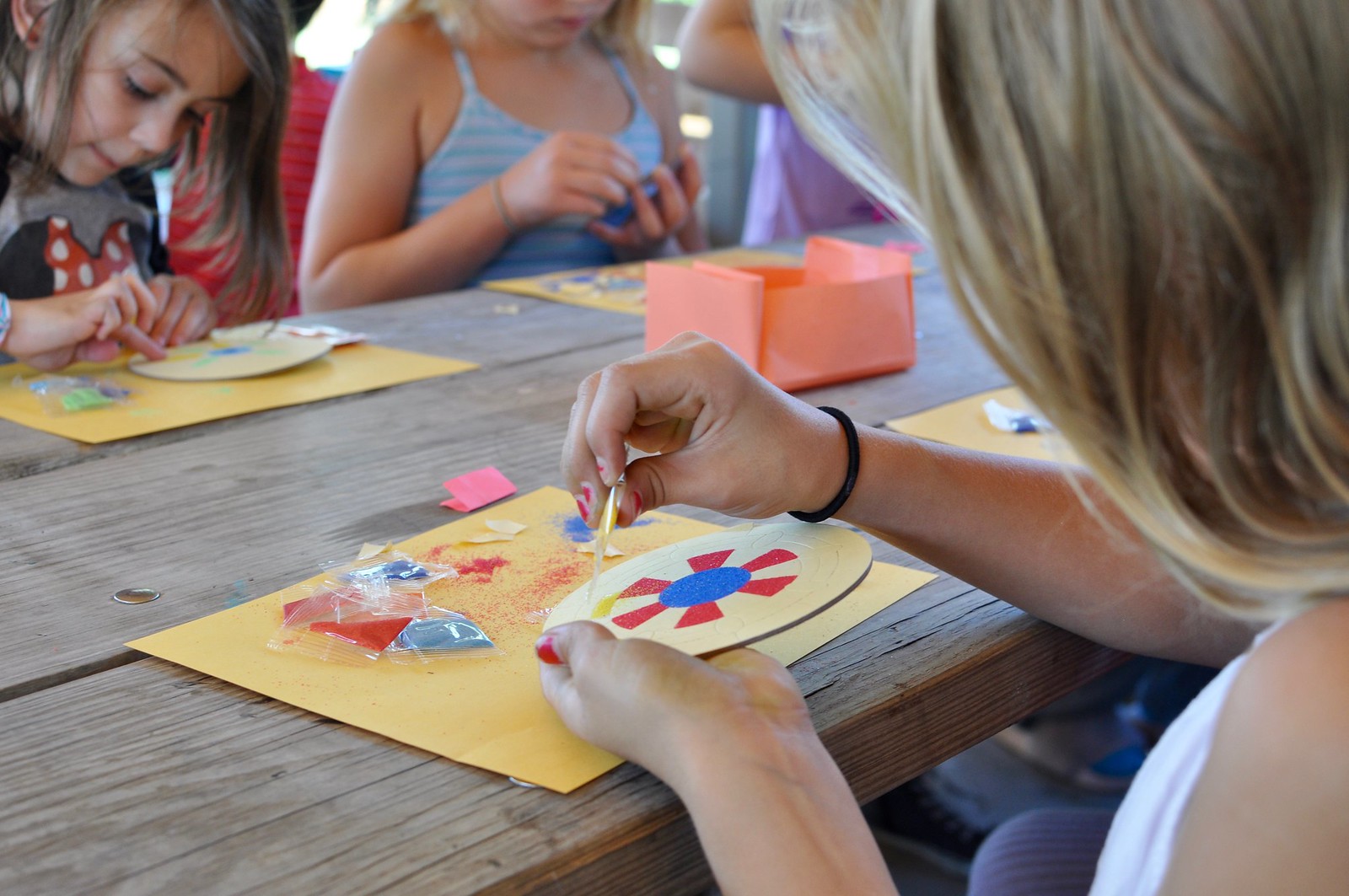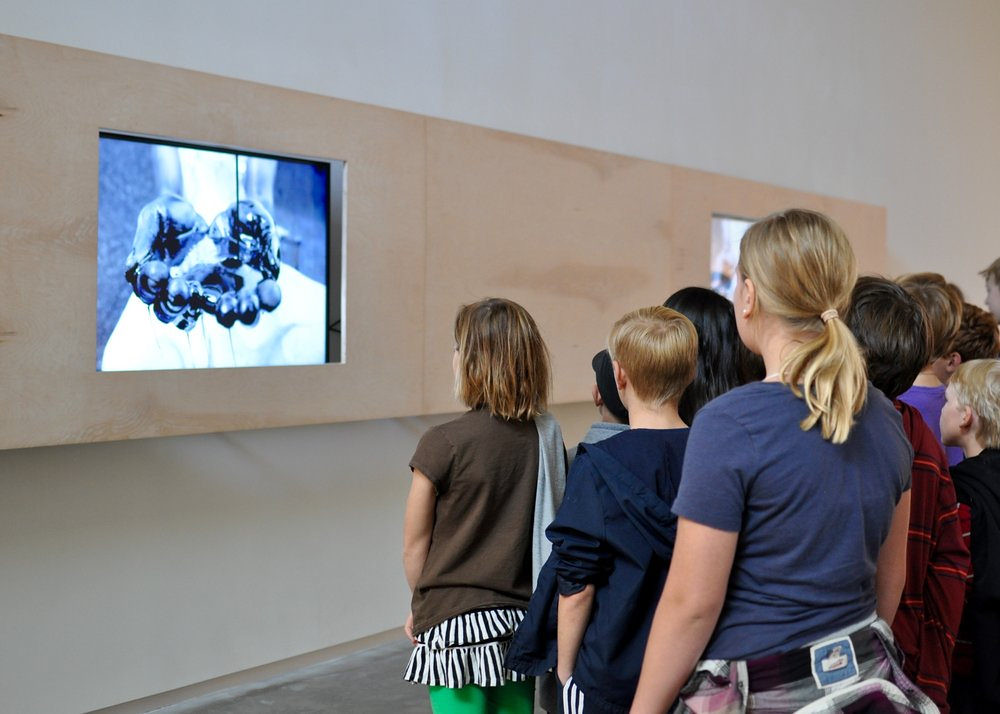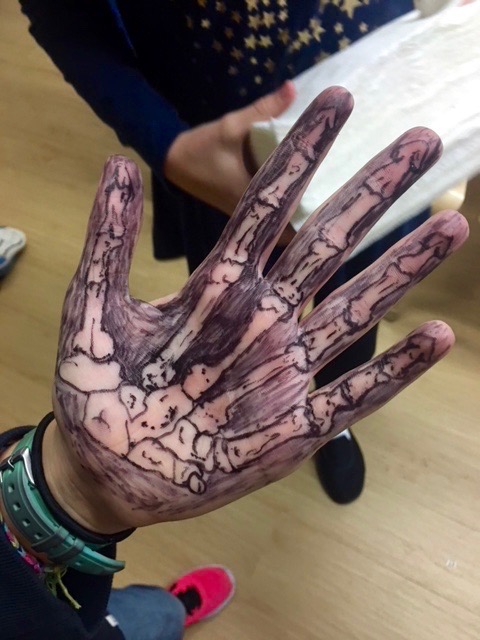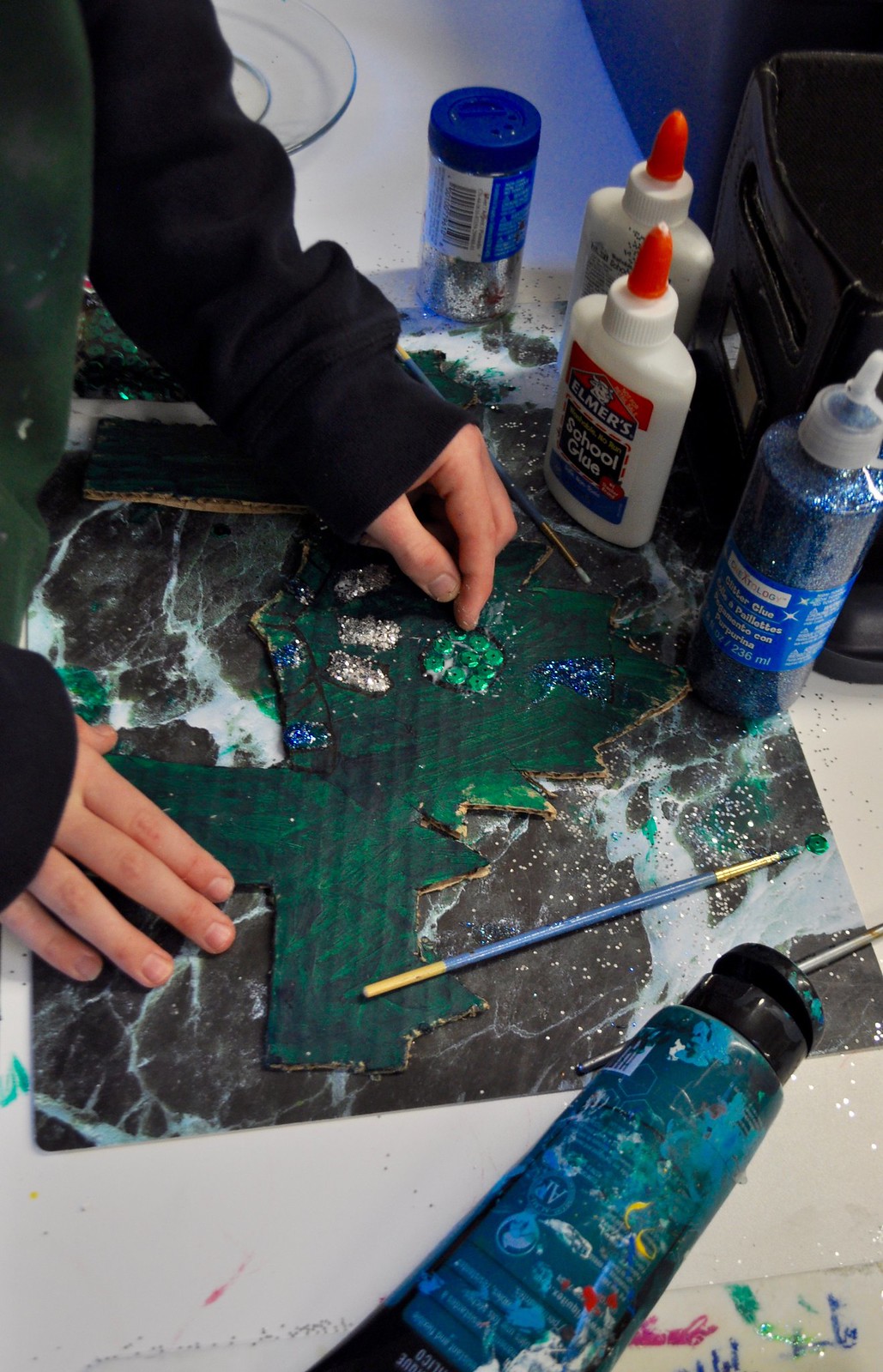 Our beloved Lower Elementary Guide Anna Schwind is moving on to fill a new position at the Montessori Lab School, where she will serve as a Guide in the new Elementary classroom. While we will miss her deeply, we are also very proud of her and know she will continue to bring the magic of Montessori to so many children. On our last day of school before summer break, here is our tribute to Anna.
Our beloved Lower Elementary Guide Anna Schwind is moving on to fill a new position at the Montessori Lab School, where she will serve as a Guide in the new Elementary classroom. While we will miss her deeply, we are also very proud of her and know she will continue to bring the magic of Montessori to so many children. On our last day of school before summer break, here is our tribute to Anna.  Head of School Laura Ceretti-Michelman shares,"Anna Schwind absolutely comes alive in the presence of elementary children. It is truly a sight to see. Her endlessly curious, passion for Montessori, and commitment to child development come together in a wonderful way. There is no doubt that Anna is a true Montessorian to her core. Anna is a champion for all who is service minded and as generous as the day is long. It has been a privilege and a pleasure learning from Anna and watching her work with VdM children as well as watching her collaborate and help whenever and wherever needed. And if you didn't have a chance to see one of Anna's parent education talks, you missed out. She really is an exceptional public speaker with clarity of thought and expression that few people possess.Anna can be animated and she has a fantastic sense of humor which make her entertaining to boot. Anna is a deep thinker and she is almost always up for a good conversation and I will most definitely miss those conversations. Anna has done so much for Villa di Maria and she will be missed. The good news is that she is moving on to do great things for the Montessori Training Center of St. Louis' new Elementary Lab School and she is the PERFECT person for the job."
Head of School Laura Ceretti-Michelman shares,"Anna Schwind absolutely comes alive in the presence of elementary children. It is truly a sight to see. Her endlessly curious, passion for Montessori, and commitment to child development come together in a wonderful way. There is no doubt that Anna is a true Montessorian to her core. Anna is a champion for all who is service minded and as generous as the day is long. It has been a privilege and a pleasure learning from Anna and watching her work with VdM children as well as watching her collaborate and help whenever and wherever needed. And if you didn't have a chance to see one of Anna's parent education talks, you missed out. She really is an exceptional public speaker with clarity of thought and expression that few people possess.Anna can be animated and she has a fantastic sense of humor which make her entertaining to boot. Anna is a deep thinker and she is almost always up for a good conversation and I will most definitely miss those conversations. Anna has done so much for Villa di Maria and she will be missed. The good news is that she is moving on to do great things for the Montessori Training Center of St. Louis' new Elementary Lab School and she is the PERFECT person for the job." From Primary Guide Heather Steinman:"I first met Anna as a fellow parent about 14 years ago right here at Villa! I have since come to know her as a teacher, a co worker and a friend. I could say many things about her, but I will say this above all - Anna is incredibly kind and extremely generous!As a friend Anna has been there for me on many an occasion without being asked or expecting fanfare. Once when I had surgery, she came and walked my dog...more than once! When I had a sad event in my family, Anna brought us dinner, put it on my doorstep and rang the bell as to not bother us. She and her husband even helped me move once! Honestly, there are so many other instances I could go on and on.As a colleague, Anna and I have spent countless amounts of time working together and talking Montessori shop, if you will. It is a really neat relationship to build on when you are a Primary directress sending children you have worked with for three (or four!) years on to an Elementary guide. We have done this pretty smoothly now over some time, learning the ins and outs together. She is always so excited to tell me about how she is getting to know the children and finding out who they are. Her attention to the details and personalities of each child are admirable.
From Primary Guide Heather Steinman:"I first met Anna as a fellow parent about 14 years ago right here at Villa! I have since come to know her as a teacher, a co worker and a friend. I could say many things about her, but I will say this above all - Anna is incredibly kind and extremely generous!As a friend Anna has been there for me on many an occasion without being asked or expecting fanfare. Once when I had surgery, she came and walked my dog...more than once! When I had a sad event in my family, Anna brought us dinner, put it on my doorstep and rang the bell as to not bother us. She and her husband even helped me move once! Honestly, there are so many other instances I could go on and on.As a colleague, Anna and I have spent countless amounts of time working together and talking Montessori shop, if you will. It is a really neat relationship to build on when you are a Primary directress sending children you have worked with for three (or four!) years on to an Elementary guide. We have done this pretty smoothly now over some time, learning the ins and outs together. She is always so excited to tell me about how she is getting to know the children and finding out who they are. Her attention to the details and personalities of each child are admirable.
Anna's knowledge of Montessori as well as the world around us never ceases to amaze me. She is truly one of a kind and I will miss seeing her face around here! Good luck on your new adventure Anna!
Oh, and I cannot forget to mention, she REALLY does not like sticky things!"
 Primary Aide Cristina Kerr adds, "Anna has great taste in music! When she first started at our school, while preparing her environment, she was always listening to music, and the tunes I was hearing certainly created a great atmosphere for cleaning and sorting materials!"
Primary Aide Cristina Kerr adds, "Anna has great taste in music! When she first started at our school, while preparing her environment, she was always listening to music, and the tunes I was hearing certainly created a great atmosphere for cleaning and sorting materials!" From Parent-Child Guide Cab Yau:
From Parent-Child Guide Cab Yau:
"Anna is brilliant, funny, joyful, and has a perfect Montessori teacher’s voice. I relish the opportunity to sing her praises publicly as I’ve tried complimenting Anna directly over the last three years, to no avail. Anna is entirely self-effacing about her Montessori skills and her classroom magic. When I mention the artistry and flat out moxie she brings to the classroom, she unfailingly turns the conversation to the children, pointing to them as the source of the magic. I then try reminding her that she set up the environment, she links the children to the materials, she provides the adult example, and the like. Every time I lose this compliment game. She always trumps my litany of her strengths with her unwavering confidence in, and respect for, the children. It is all about the children. Of course, by winning this game she proves over and again why she is the quintessential Montessori teacher. She embodies what Dr. Montessori asked of us. To observe the child, respect the child, acknowledge that the child is the builder of mankind. Children couldn’t ask for better support in this process than Anna Schwind.
Thank you Anna for always being focused on the children. Thank you for holding children accountable. Thank you for priming the pump for independent reading by choosing read aloud books that are the first in a series. Thank you for teaching me how to be a better parent. Thank you for spending time with us here at Villa. Thank you for continuing to serve the building of mankind by bringing Montessori elementary to a new place. Best of everything to you."
 Upper Elementary Guide Rebecca Callander-Liddy shares:
Upper Elementary Guide Rebecca Callander-Liddy shares:
“The secret of good teaching is to regard the child’s intelligence as a fertile field in which seeds may be sown to grow under the heat of flaming imagination.” Those words of Dr. Montessori, so wisely urge us as adults to look into each child and see them, truly see them—their potential, their kindness, their citizenship—and weave tales of academic wonder such that all subjects are seen as one wonderful path to explore. Anna embodies this task of the teacher every day she steps foot onto the campus. She been a gift to Villa di Maria for the past three years and has definitely made her mark on our elementary program.
Anna is the consummate storyteller and has a way of making every lesson seem like the most secret and irresistible golden treasure. During an observation this past spring, I witnessed this magic when, during a story lesson on the Dust Bowl and the Great Depression, the class dynamically went from a conversational hum to a hushed silence, with the entire community pausing from their work, though they were not all in the lesson, to hear the content of her story. I can only imagine what seeds were planted this day—seeds of compassion, of human struggle, of science and ecology. It was amazing.
In addition to her gift of storytelling, Anna has brought so much else to our elementary community—her understanding of the needs of the child is unparalleled. Even as the proverbial old dog, I have learned so many tricks from Anna’s ability to establish clear classroom rules and operations. She is one of the most consistent and stable adults I know and provides a place for children to feel safe, knowing that the rules are always so. Stability in the prepared environment helps children to focus on their own internal growth without having to question the external day-to-day changes that can be so prevalent in life. Anna’s children have come to the Upper Elementary as self-regulated individuals as a result of their time in her centered community.
Finally, Anna, at her core, is an advocate for peace and the rights of the child, being a stand for the emotional growth of each person in her room. She guides from a place of love, compassion, and fairness, and follows the unique needs of each child, which can look quite different depending on the individual. In the words of Rick Riordan from the Red Pyramid, Anna knows that “Fairness doesn’t mean that everybody gets the same. Fairness means everyone gets what they need.”
I am going to miss seeing Mrs. Schwind each day, but I know that she will be just around the corner at the Lab School, bringing her Montessori work to a new 6-12 community. I am also given solace knowing that in a few years, we will hopefully be able to participate in the NYC MMUN together!"
 "Anna will most definitely be missed. She's so thoughtful and cares deeply about both children and her peers. Villa di Maria's legacy will be even stronger having had her as part of the team." - Jade Venditte, Director of Development, Diversity and Inclusion
"Anna will most definitely be missed. She's so thoughtful and cares deeply about both children and her peers. Villa di Maria's legacy will be even stronger having had her as part of the team." - Jade Venditte, Director of Development, Diversity and Inclusion From Classroom Aide (and the one who worked most closely with Anna over the past two years) Melinda Smith:“A” teamOur fling is doneBefore I had the chanceFor the second rule of cinquainWeak sauce"Anna knows how I feel about her. We are fabulous and unbelievably magical. If you will, the unicorn of partners! We have been since the beginning. She supports me and stands by me, she includes and collaborates with me, she trusts and teaches me. She is modeling for the children what a working relationship looks like, both for friendships and teammates in the classroom.No longer work buddies but just buddies with a future of dog walking and handwork classes. I know she will always be there to guide me when I need it because she is totally awesome sauce."
From Classroom Aide (and the one who worked most closely with Anna over the past two years) Melinda Smith:“A” teamOur fling is doneBefore I had the chanceFor the second rule of cinquainWeak sauce"Anna knows how I feel about her. We are fabulous and unbelievably magical. If you will, the unicorn of partners! We have been since the beginning. She supports me and stands by me, she includes and collaborates with me, she trusts and teaches me. She is modeling for the children what a working relationship looks like, both for friendships and teammates in the classroom.No longer work buddies but just buddies with a future of dog walking and handwork classes. I know she will always be there to guide me when I need it because she is totally awesome sauce." From fellow Lower Elementary Guide Megan Eilers:
From fellow Lower Elementary Guide Megan Eilers:
"Working with Anna over the past two years has been a privilege and a pleasure. When I first arrived on the scene at Villa, fresh from training, Anna took me under her wing and helped me prepare for the school year. I could tell from the start that we would make a great team.
As the newbie, I relied heavily on Anna’s expertise and guidance. Whenever I had an idea, question or concern, Anna was there to support and encourage me. If you know Anna, you know she has a way with words. I have always been dazzled by her expansive knowledge and her ability to articulate her thoughts so precisely. Any time that I had an issue with something, I would present it to Anna and she would answer back with several practical solutions (she is always spot on!). She would then take it a step further and check in on me to see if I needed any further help or support. I can’t thank Anna enough for the countless before/during/after school chats and all the advice and encouragement she has given me.
Throughout our time leading the lower elementary together, Anna has been incredibly supportive, understanding and flexible. I have learned so much from our conversations and simply by watching her interact with children. I know that I have really been spoiled over the last two years. Anna has not only been my own personal Montessori “Google,” but she has been one of the easiest coworkers I have ever worked with. She is flexible and able to adapt to any occasion. Whether planning for cross-over lessons, celebrations, Parent Ed nights or just having impromptu activities, Anna is always willing to go with the flow and adjust her schedule. We compliment each other very well and I will miss the ease of our working relationship.
The time I have spent with Anna and the lessons that I have learned from her are invaluable. I will always be grateful to her for helping me through my first couple years of teaching. Anna, your new school does not know how lucky they are to have you! You are an amazing coworker, mentor and friend, and I will miss you dearly!"
And from Lower Elementary Aide Sophie Andre:
"Dear Anna,
Thank you for all you did at Villa, all that you taught me and all I learned by observing you. I will also preciously keep with me one of your thoughts about parenting : We will inevitably pass burdens to our children, so what matters, in the end, is to give more positive than negative.
I hope your new adventure will be colorful and delightful!
Yours friendly, Namaste"
 Jessie Braud, Primary Guide, had this message for Anna:
Jessie Braud, Primary Guide, had this message for Anna:
"Oh, Ms. Schwind!! What a fabulous human. She's been such a great buddy to have these past two years that I've been at VdM, whether it be through her marvelous efforts to keep my Spanish up to snuff or some bonding over our favorite nerdy hobbies. Not only that, but watching her work with the children is an inspiration, and she's helped me understand the second-plane child so much more than I had before I met her.
If you know Anna, you know that she is not the most quiet of individuals (you can hear that laugh cross-campus!) - and her rallying cries of support for me during my first two years as a directress were definitely some of the loudest in my heart. Knowing that someone like Anna had my back (and knowing that she still does and always will) has been a real encouragement to me, especially when I needed it the most.
Even though she will certainly be missed, she is off to do some huge, huge work, and I can't imagine anyone else tackling the job! I hope she is able to hear me cheering her on from VdM next year. ¡Buena suerte, Sra. Schwind!"
 My own personal experience, both from a parent and a staff perspective, has been a wonderful and inspiring one. When I began blogging for Villa di Maria two years ago, I was apprehensive; there was (and still is) so much I didn't know about the Montessori world. But I quickly learned that Anna was an incredibly patient and responsive sounding board for ideas and Montessori knowledge. On more than one occasion, she provided "lightbulb moments" for me, allowing for information and ways of being to click into place. I never hesitated to contact her with clarifications or questions about the Montessori world, and she always, always made time for me (though I have no idea how!).As a parent, I watched as she guided my oldest son, then my middle son, in the most gentle and patient ways. She has aided in my middle child's blossoming and confidence over the past three years. Upon our first parent-teacher conference, I was struck by just how well she knew my individual children; she just gets children in a deep and profound way - from who they are to what they need. She is, not using the word lightly, exceptional, and I will miss her both as a Guide and as a person.In addition to being a mindful and magical presence in the classroom, Anna has been one of our blog's major contributors over the past two years. She is full of great ideas, and is willing to take the time to discuss and even write eloquently about many Montessori topics. We consider ourselves beyond lucky to have just a fraction of her knowledge accessible here on the blog. Below, some of Anna's major blog contributions over the past two years.The Benefits of Handwork for Children (Anna discusses the many wonderful reasons we love the sensorial and creative act of working with one's hands)On Peer Conflict (Anna explains the importance of guiding children through the social learning required when navigating conflict with peers)Development of the Will: The Emergence of Self-Discipline (Anna writes about the self-regulatory work of an emerging will)Yoga in the Classroom (Anna lets us join a classroom yoga session)Modeling and Facilitating Conflict Resolution (Anna discusses, along with Rebecca and Megan, “Conscious Social Growth of the Elementary Child” and tips on how to handle conflict between siblings at home)The Role of the Contrarian in the Lower Elementary Classroom (Anna writes about why it is actually beneficial to have a contrarian in the classroom, and how it helps with personal and group growth)The Weekly Conference (Anna discusses the structure of this self-assessment tool)Spanish with Mrs. Schwind (A peek into Anna's Spanish class)Torta Frita: A Traditional Argentine Recipe (Anna shares a recipe from her childhood home)The Great Lessons (Anna brings magic and wonder to children as she presents one of the Great Lessons during the first week of school in the new Elementary building)Anna, thank you for your outstanding commitment to Montessori! We wish you the best of luck in your next endeavor!
My own personal experience, both from a parent and a staff perspective, has been a wonderful and inspiring one. When I began blogging for Villa di Maria two years ago, I was apprehensive; there was (and still is) so much I didn't know about the Montessori world. But I quickly learned that Anna was an incredibly patient and responsive sounding board for ideas and Montessori knowledge. On more than one occasion, she provided "lightbulb moments" for me, allowing for information and ways of being to click into place. I never hesitated to contact her with clarifications or questions about the Montessori world, and she always, always made time for me (though I have no idea how!).As a parent, I watched as she guided my oldest son, then my middle son, in the most gentle and patient ways. She has aided in my middle child's blossoming and confidence over the past three years. Upon our first parent-teacher conference, I was struck by just how well she knew my individual children; she just gets children in a deep and profound way - from who they are to what they need. She is, not using the word lightly, exceptional, and I will miss her both as a Guide and as a person.In addition to being a mindful and magical presence in the classroom, Anna has been one of our blog's major contributors over the past two years. She is full of great ideas, and is willing to take the time to discuss and even write eloquently about many Montessori topics. We consider ourselves beyond lucky to have just a fraction of her knowledge accessible here on the blog. Below, some of Anna's major blog contributions over the past two years.The Benefits of Handwork for Children (Anna discusses the many wonderful reasons we love the sensorial and creative act of working with one's hands)On Peer Conflict (Anna explains the importance of guiding children through the social learning required when navigating conflict with peers)Development of the Will: The Emergence of Self-Discipline (Anna writes about the self-regulatory work of an emerging will)Yoga in the Classroom (Anna lets us join a classroom yoga session)Modeling and Facilitating Conflict Resolution (Anna discusses, along with Rebecca and Megan, “Conscious Social Growth of the Elementary Child” and tips on how to handle conflict between siblings at home)The Role of the Contrarian in the Lower Elementary Classroom (Anna writes about why it is actually beneficial to have a contrarian in the classroom, and how it helps with personal and group growth)The Weekly Conference (Anna discusses the structure of this self-assessment tool)Spanish with Mrs. Schwind (A peek into Anna's Spanish class)Torta Frita: A Traditional Argentine Recipe (Anna shares a recipe from her childhood home)The Great Lessons (Anna brings magic and wonder to children as she presents one of the Great Lessons during the first week of school in the new Elementary building)Anna, thank you for your outstanding commitment to Montessori! We wish you the best of luck in your next endeavor!
 Our beloved Lower Elementary Guide Anna Schwind is moving on to fill a new position at the Montessori Lab School, where she will serve as a Guide in the new Elementary classroom. While we will miss her deeply, we are also very proud of her and know she will continue to bring the magic of Montessori to so many children. On our last day of school before summer break, here is our tribute to Anna.
Our beloved Lower Elementary Guide Anna Schwind is moving on to fill a new position at the Montessori Lab School, where she will serve as a Guide in the new Elementary classroom. While we will miss her deeply, we are also very proud of her and know she will continue to bring the magic of Montessori to so many children. On our last day of school before summer break, here is our tribute to Anna.  Head of School Laura Ceretti-Michelman shares,"Anna Schwind absolutely comes alive in the presence of elementary children. It is truly a sight to see. Her endlessly curious, passion for Montessori, and commitment to child development come together in a wonderful way. There is no doubt that Anna is a true Montessorian to her core. Anna is a champion for all who is service minded and as generous as the day is long. It has been a privilege and a pleasure learning from Anna and watching her work with VdM children as well as watching her collaborate and help whenever and wherever needed. And if you didn't have a chance to see one of Anna's parent education talks, you missed out. She really is an exceptional public speaker with clarity of thought and expression that few people possess.Anna can be animated and she has a fantastic sense of humor which make her entertaining to boot. Anna is a deep thinker and she is almost always up for a good conversation and I will most definitely miss those conversations. Anna has done so much for Villa di Maria and she will be missed. The good news is that she is moving on to do great things for the Montessori Training Center of St. Louis' new Elementary Lab School and she is the PERFECT person for the job."
Head of School Laura Ceretti-Michelman shares,"Anna Schwind absolutely comes alive in the presence of elementary children. It is truly a sight to see. Her endlessly curious, passion for Montessori, and commitment to child development come together in a wonderful way. There is no doubt that Anna is a true Montessorian to her core. Anna is a champion for all who is service minded and as generous as the day is long. It has been a privilege and a pleasure learning from Anna and watching her work with VdM children as well as watching her collaborate and help whenever and wherever needed. And if you didn't have a chance to see one of Anna's parent education talks, you missed out. She really is an exceptional public speaker with clarity of thought and expression that few people possess.Anna can be animated and she has a fantastic sense of humor which make her entertaining to boot. Anna is a deep thinker and she is almost always up for a good conversation and I will most definitely miss those conversations. Anna has done so much for Villa di Maria and she will be missed. The good news is that she is moving on to do great things for the Montessori Training Center of St. Louis' new Elementary Lab School and she is the PERFECT person for the job." From Primary Guide Heather Steinman:"I first met Anna as a fellow parent about 14 years ago right here at Villa! I have since come to know her as a teacher, a co worker and a friend. I could say many things about her, but I will say this above all - Anna is incredibly kind and extremely generous!As a friend Anna has been there for me on many an occasion without being asked or expecting fanfare. Once when I had surgery, she came and walked my dog...more than once! When I had a sad event in my family, Anna brought us dinner, put it on my doorstep and rang the bell as to not bother us. She and her husband even helped me move once! Honestly, there are so many other instances I could go on and on.As a colleague, Anna and I have spent countless amounts of time working together and talking Montessori shop, if you will. It is a really neat relationship to build on when you are a Primary directress sending children you have worked with for three (or four!) years on to an Elementary guide. We have done this pretty smoothly now over some time, learning the ins and outs together. She is always so excited to tell me about how she is getting to know the children and finding out who they are. Her attention to the details and personalities of each child are admirable.
From Primary Guide Heather Steinman:"I first met Anna as a fellow parent about 14 years ago right here at Villa! I have since come to know her as a teacher, a co worker and a friend. I could say many things about her, but I will say this above all - Anna is incredibly kind and extremely generous!As a friend Anna has been there for me on many an occasion without being asked or expecting fanfare. Once when I had surgery, she came and walked my dog...more than once! When I had a sad event in my family, Anna brought us dinner, put it on my doorstep and rang the bell as to not bother us. She and her husband even helped me move once! Honestly, there are so many other instances I could go on and on.As a colleague, Anna and I have spent countless amounts of time working together and talking Montessori shop, if you will. It is a really neat relationship to build on when you are a Primary directress sending children you have worked with for three (or four!) years on to an Elementary guide. We have done this pretty smoothly now over some time, learning the ins and outs together. She is always so excited to tell me about how she is getting to know the children and finding out who they are. Her attention to the details and personalities of each child are admirable.
 Primary Aide Cristina Kerr adds, "Anna has great taste in music! When she first started at our school, while preparing her environment, she was always listening to music, and the tunes I was hearing certainly created a great atmosphere for cleaning and sorting materials!"
Primary Aide Cristina Kerr adds, "Anna has great taste in music! When she first started at our school, while preparing her environment, she was always listening to music, and the tunes I was hearing certainly created a great atmosphere for cleaning and sorting materials!" From Parent-Child Guide Cab Yau:
From Parent-Child Guide Cab Yau:
 Upper Elementary Guide Rebecca Callander-Liddy shares:
Upper Elementary Guide Rebecca Callander-Liddy shares:
 "Anna will most definitely be missed. She's so thoughtful and cares deeply about both children and her peers. Villa di Maria's legacy will be even stronger having had her as part of the team." - Jade Venditte, Director of Development, Diversity and Inclusion
"Anna will most definitely be missed. She's so thoughtful and cares deeply about both children and her peers. Villa di Maria's legacy will be even stronger having had her as part of the team." - Jade Venditte, Director of Development, Diversity and Inclusion From Classroom Aide (and the one who worked most closely with Anna over the past two years) Melinda Smith:“A” teamOur fling is doneBefore I had the chanceFor the second rule of cinquainWeak sauce"Anna knows how I feel about her. We are fabulous and unbelievably magical. If you will, the unicorn of partners! We have been since the beginning. She supports me and stands by me, she includes and collaborates with me, she trusts and teaches me. She is modeling for the children what a working relationship looks like, both for friendships and teammates in the classroom.No longer work buddies but just buddies with a future of dog walking and handwork classes. I know she will always be there to guide me when I need it because she is totally awesome sauce."
From Classroom Aide (and the one who worked most closely with Anna over the past two years) Melinda Smith:“A” teamOur fling is doneBefore I had the chanceFor the second rule of cinquainWeak sauce"Anna knows how I feel about her. We are fabulous and unbelievably magical. If you will, the unicorn of partners! We have been since the beginning. She supports me and stands by me, she includes and collaborates with me, she trusts and teaches me. She is modeling for the children what a working relationship looks like, both for friendships and teammates in the classroom.No longer work buddies but just buddies with a future of dog walking and handwork classes. I know she will always be there to guide me when I need it because she is totally awesome sauce." From fellow Lower Elementary Guide Megan Eilers:
From fellow Lower Elementary Guide Megan Eilers:
 Jessie Braud, Primary Guide, had this message for Anna:
Jessie Braud, Primary Guide, had this message for Anna:
 My own personal experience, both from a parent and a staff perspective, has been a wonderful and inspiring one. When I began blogging for Villa di Maria two years ago, I was apprehensive; there was (and still is) so much I didn't know about the Montessori world. But I quickly learned that Anna was an incredibly patient and responsive sounding board for ideas and Montessori knowledge. On more than one occasion, she provided "lightbulb moments" for me, allowing for information and ways of being to click into place. I never hesitated to contact her with clarifications or questions about the Montessori world, and she always, always made time for me (though I have no idea how!).As a parent, I watched as she guided my oldest son, then my middle son, in the most gentle and patient ways. She has aided in my middle child's blossoming and confidence over the past three years. Upon our first parent-teacher conference, I was struck by just how well she knew my individual children; she just gets children in a deep and profound way - from who they are to what they need. She is, not using the word lightly, exceptional, and I will miss her both as a Guide and as a person.In addition to being a mindful and magical presence in the classroom, Anna has been one of our blog's major contributors over the past two years. She is full of great ideas, and is willing to take the time to discuss and even write eloquently about many Montessori topics. We consider ourselves beyond lucky to have just a fraction of her knowledge accessible here on the blog. Below, some of Anna's major blog contributions over the past two years.The Benefits of Handwork for Children (Anna discusses the many wonderful reasons we love the sensorial and creative act of working with one's hands)On Peer Conflict (Anna explains the importance of guiding children through the social learning required when navigating conflict with peers)Development of the Will: The Emergence of Self-Discipline (Anna writes about the self-regulatory work of an emerging will)Yoga in the Classroom (Anna lets us join a classroom yoga session)Modeling and Facilitating Conflict Resolution (Anna discusses, along with Rebecca and Megan, “Conscious Social Growth of the Elementary Child” and tips on how to handle conflict between siblings at home)The Role of the Contrarian in the Lower Elementary Classroom (Anna writes about why it is actually beneficial to have a contrarian in the classroom, and how it helps with personal and group growth)The Weekly Conference (Anna discusses the structure of this self-assessment tool)Spanish with Mrs. Schwind (A peek into Anna's Spanish class)Torta Frita: A Traditional Argentine Recipe (Anna shares a recipe from her childhood home)The Great Lessons (Anna brings magic and wonder to children as she presents one of the Great Lessons during the first week of school in the new Elementary building)Anna, thank you for your outstanding commitment to Montessori! We wish you the best of luck in your next endeavor!
My own personal experience, both from a parent and a staff perspective, has been a wonderful and inspiring one. When I began blogging for Villa di Maria two years ago, I was apprehensive; there was (and still is) so much I didn't know about the Montessori world. But I quickly learned that Anna was an incredibly patient and responsive sounding board for ideas and Montessori knowledge. On more than one occasion, she provided "lightbulb moments" for me, allowing for information and ways of being to click into place. I never hesitated to contact her with clarifications or questions about the Montessori world, and she always, always made time for me (though I have no idea how!).As a parent, I watched as she guided my oldest son, then my middle son, in the most gentle and patient ways. She has aided in my middle child's blossoming and confidence over the past three years. Upon our first parent-teacher conference, I was struck by just how well she knew my individual children; she just gets children in a deep and profound way - from who they are to what they need. She is, not using the word lightly, exceptional, and I will miss her both as a Guide and as a person.In addition to being a mindful and magical presence in the classroom, Anna has been one of our blog's major contributors over the past two years. She is full of great ideas, and is willing to take the time to discuss and even write eloquently about many Montessori topics. We consider ourselves beyond lucky to have just a fraction of her knowledge accessible here on the blog. Below, some of Anna's major blog contributions over the past two years.The Benefits of Handwork for Children (Anna discusses the many wonderful reasons we love the sensorial and creative act of working with one's hands)On Peer Conflict (Anna explains the importance of guiding children through the social learning required when navigating conflict with peers)Development of the Will: The Emergence of Self-Discipline (Anna writes about the self-regulatory work of an emerging will)Yoga in the Classroom (Anna lets us join a classroom yoga session)Modeling and Facilitating Conflict Resolution (Anna discusses, along with Rebecca and Megan, “Conscious Social Growth of the Elementary Child” and tips on how to handle conflict between siblings at home)The Role of the Contrarian in the Lower Elementary Classroom (Anna writes about why it is actually beneficial to have a contrarian in the classroom, and how it helps with personal and group growth)The Weekly Conference (Anna discusses the structure of this self-assessment tool)Spanish with Mrs. Schwind (A peek into Anna's Spanish class)Torta Frita: A Traditional Argentine Recipe (Anna shares a recipe from her childhood home)The Great Lessons (Anna brings magic and wonder to children as she presents one of the Great Lessons during the first week of school in the new Elementary building)Anna, thank you for your outstanding commitment to Montessori! We wish you the best of luck in your next endeavor!




























